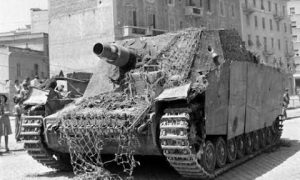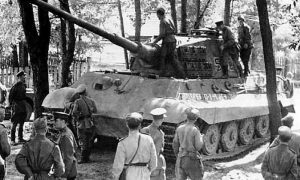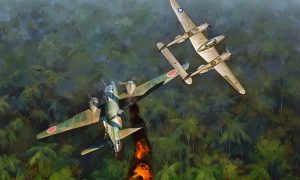Operation Barbarossa – Invasion of the Soviet Union
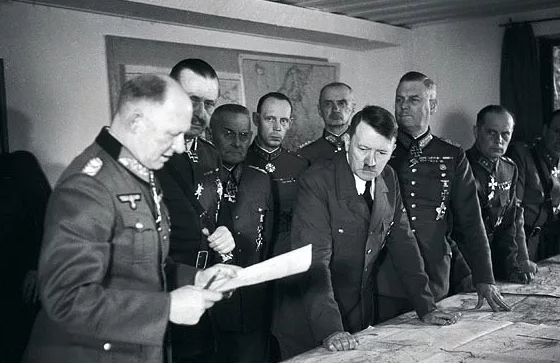
Hitler Meeting Officer Before Operation Barbarossa
Operation Barbarossa (Directive No. 21. Plan “Barbarossa”; German Weisung Nr. 21. Fall Barbarossa, Italian. Operazione Barbarossa in honor of the King of Germany and Holy Roman Emperor Frederick I Staufen, nicknamed Barbarossa) – developed in December 1940 – June 1941, the strategic plan for the attack of Nazi Germany on the USSR and the military operation of the same name, carried out at the initial stage of the Eastern Front in WW2.
Hitler’s decision to carry out Operation Barbarossa against the USSR marked a turning point in the history of Nazi Germany, leading him to a two-front war and the collapse of the Nazi regime less than four years later. When developing the Barbarossa plan, designed only for a “blitzkrieg”, the enemy was initially underestimated and the possibility of a fleeting war developing into a protracted one was not taken into account. By September 30, the blitzkrieg (lightning war) had lost its momentum. This allowed the Red Army to stabilize the front line. As a result, the failure of Operation Barbarossa was the turning point of the Second World War.
Military-political situation
With the coming to power in Germany of the NSDAP and Adolf Hitler (1933), revanchist sentiments sharply increased in the country. Nazi propaganda convinced the Germans of the need to conquer living space in the East. Already, in the mid-1930s, the leadership of Nazi Germany announced the inevitability of a war with the USSR in the near future. In 1939, planning an attack on Poland and foreseeing the possible entry into the war on its side of Great Britain and France, the German leadership decided to secure itself from the east – in August, a Non-Aggression Pact was concluded between Germany and the USSR, after which the Reich and the USSR divided among themselves “spheres of interest” in Eastern Europe, mutually suspended propaganda against each other and began multilateral cooperation.
On September 1, 1939, Germany attacked Poland, causing Britain and France to declare war on Germany. On September 17, the Soviet Union carried out an invasion of Poland, annexing what is now Western Ukraine and Western Belarus. A common border appeared between Germany and the USSR.
In 1940, Germany invaded Denmark, Norway, Belgium, the Netherlands, Luxembourg and defeated France. Thus, by June 1940, Germany managed to radically change the strategic situation in Europe, withdraw France from the war and expel the British army from the continent. The victories of the Wehrmacht gave rise to hopes in Berlin for an early end to the war with England, which would allow Germany to devote all its forces to the defeat of the USSR, and this would give her a free hand to fight the United States. However, Germany failed to force Britain to make peace. The war continued, at sea, in North Africa and in the Balkans. In June 1940, preparations began for implementing the plan for an amphibious operation to land a combined landing on the English coast under the name “Sea Lion”. In planning, however, the Wehrmacht command gradually knew a throw across the English Channel could turn into an operation with an uncertain result, associated with heavy losses.
In October 1940, the preparation of the “Sea Lion” was curtailed until the spring of 1941. Germany attempted to bring Francoist Spain and Vichy France into an alliance against England, and also re-starting negotiations with the USSR. At the Soviet-German negotiations in November 1940, Germany offered the USSR, by the Four Powers Pact, to finally join the “Axis countries” under the Tripartite Pact (Francoist Spain, to which the USSR had a bad attitude after participation of Soviet volunteers in the civil war) and “sharing the inheritance of England”, but the USSR, formally recognizing the possibility of such a step, set conditions that were clearly unacceptable for Germany, and a month later Germany accepted the Barbarossa plan for implementation.
On January 9, 1941, at a meeting with the military command at the Berghof, Hitler said:
The British are supported by the hope of the possibility of Russian intervention. They will only give up resistance when this last continental hope of theirs is crushed. He, the Fuhrer, does not believe that the British are “hopelessly stupid”; if they do not see any prospect, they will stop fighting. If they lose, they will never find the moral strength to save the empire. If they can hold out, form 30-40 divisions, and if the United States and Russia provide them with assistance, then a very difficult situation will be created for Germany. This cannot be allowed…
… Therefore, now it is necessary to defeat Russia. Then either England will surrender, or Germany will continue to fight against England under the most favorable conditions. The defeat of Russia will also allow Japan to turn all its forces against the United States. And this would keep the latter from entering the war.
The question of time is especially important for the defeat of Russia. Although the Russian armed forces are a clay colossus without a head, it is impossible to accurately predict their further development. Since Russia must be defeated in any case, it is better to do so now, when the Russian army is leaderless and ill-prepared, and when the Russians have to overcome great difficulties in the military industry created with outside help…
… The defeat of Russia will mean great relief for Germany. Then only 40-50 divisions would have to be left in the East, the strength of the land army could be reduced, and the entire military industry could be used to arm the air and naval forces. Then it will be necessary to create a reliable anti-aircraft cover and move the most important industrial enterprises to safe areas. Then Germany will be invulnerable.
The gigantic expanses of Russia are fraught with incalculable riches. Germany must take possession of these areas economically and politically, but not annex them. Thus, it will have all the possibilities for waging a future struggle against the continents, then no one can defeat it anymore. When this operation is carried out, Europe will hold its breath.
Preparing for Operation Barbarossa
Disguise and disinformation
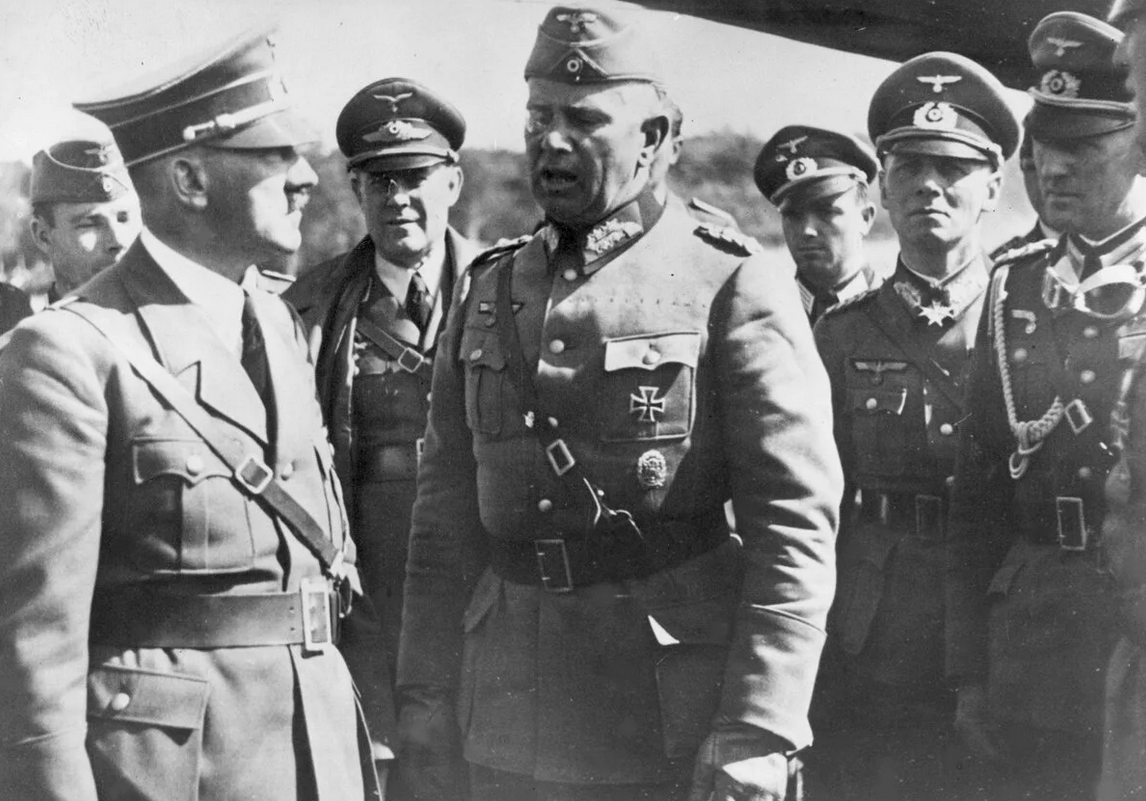
Hitler Meeting Troops
From the very beginning of planning a war against the USSR, an important place in the activities of the German military-political leadership and the command of the Wehrmacht was occupied by issues of disinformation, strategic and operational camouflage, aimed at misleading the leadership of the USSR regarding the timing of a possible German attack on the Soviet Union.
Creating favorable conditions for preparing for war, Hitler covered up his aggressive plans with diplomatic measures, which were designed to demonstrate to the Soviet leadership a relatively high level of development of Soviet-German relations. Against the background of the demonstration of these “good-neighborly” relations, a gradual transfer of German troops from the western to the eastern direction began and the stage-by-stage equipment of the theater of the future war (see Aufbau Ost). The increase in the volume of production of weapons, military equipment and other military goods, as well as the implementation of additional mobilization measures, were explained by the need to wage war against Great Britain.
Assessing the measures taken to misinform the Soviet leadership, Goebbels wrote in his diary in the summer of 1941: “… The Fuhrer is extremely pleased that the disguise of preparations for the eastern campaign was completely successful… The whole maneuver was carried out with incredible cunning”.
Participation of senior officials in disinformation activities
Hitler himself, Foreign Minister Ribbentrop, Propaganda Minister Goebbels, Chief of the General Staff of the Ground Forces Halder, Head of Department E (counterintelligence) of the IV Directorate of the RSHA (Gestapo) V. Schellenberg, Head of the military intelligence and counterintelligence service Admiral V. Canaris and some other high-ranking officials. The main measures to misinform the Soviet leadership were carried out under the direct supervision of Hitler and in some cases with his personal participation.
Top officials of the German leadership, German ambassadors and diplomats, military attachés, German political and military intelligence officers who operated in European countries and the Far East, members of German government and trade and economic delegations who visited Moscow and the capitals took part in the dissemination of disinformation information. other European states, the German media.
Disinformation activities in the political field were supposed to demonstrate Hitler’s commitment to the Soviet-German non-aggression pact, to convince the Soviet leadership that Germany had no territorial claims against the USSR, to intensify Soviet-German contacts at the highest level to discuss various international problems, which would allow Soviet representatives to create a positive impression of the state of Soviet-German relations. Great importance was attached to preventing the creation of a bloc of anti-fascist states in Europe.
Hitler’s official messages to the Soviet leadership at the end of September 1940, in which the Fuhrer first informed Stalin about the upcoming signing of the pact with Japan, and then invited him to take part in the division of the “English inheritance” in Iran and India (see Four Power Pact). On October 13, Stalin received a letter from German Foreign Minister Ribbentrop, which contained an invitation to USSR People’s Commissar for Foreign Affairs Molotov to pay a visit to Berlin. In this letter, Ribbentrop also specifically emphasized that “… Germany is determined to wage war against England and her empire until Britain is finally broken…”. The Kremlin, trusting the content of Hitler’s message, suggested that the most likely period for the aggravation of Soviet-German relations could be the period after the end of the Anglo-German military conflict, which could end in two or three years, that is, in 1942-1943. On November 12-13, negotiations between Ribbentrop and Molotov took place in Berlin, at which the Soviet leadership was again offered to deal with the “sharing of the inheritance of England”, thus convincing the USSR that that the war with England is the paramount task for Germany in the coming years. Upon their completion, an official statement was published in the press stating that “… the exchange of views proceeded in an atmosphere of mutual trust and established mutual understanding on all the most important issues of interest to the USSR and Germany.” This phrase was inserted into the draft report prepared by Molotov on Stalin’s instructions. The German side accepted this wording without objection. Meanwhile, back on November 12, Hitler signed Directive No. 18, which he ordered to continue preparing a plan for a war against the USSR “… regardless of the results” of negotiations with Molotov that “… the exchange of views proceeded in an atmosphere of mutual trust and established mutual understanding on all the most important issues of interest to the USSR and Germany.” This phrase was inserted into the draft report prepared by Molotov on Stalin’s instructions. The German side accepted this wording without objection. Meanwhile, back on November 12, Hitler signed Directive No. 18, which he ordered to continue preparing a plan for a war against the USSR “… regardless of the results” of negotiations with Molotov that “… the exchange of views proceeded in an atmosphere of mutual trust and established mutual understanding on all the most important issues of interest to the USSR and Germany.” This phrase was inserted into the draft report prepared by Molotov on Stalin’s instructions. The German side accepted this wording without objection. Meanwhile, back on November 12, Hitler signed Directive No. 18, which he ordered to continue preparing a plan for a war against the USSR “… regardless of the results” of negotiations with Molotov.
A month after the negotiations in Berlin, on December 18, 1940, Hitler signed Directive No. 21 (Operation Barbarossa) on preparations for war against the Soviet Union, beginning with the instruction: “… The German armed forces must be ready to defeat Soviet Russia during a short campaign before the end of the war against England.” And the very next day, Hitler arranged a reception for the new Soviet ambassador to Germany, V. G. Dekanozov.
By misleading Stalin, Hitler sought to keep in the dark about his military plans and the leaders of Germany’s allied states for some time. Every effort was made to prevent any leakage of information about Germany’s preparations for an attack on the Soviet Union.
Masking of the activities of the armed forces in preparation for the “Eastern campaign”
On September 6, 1940, a special order was issued by the Chief of Staff of the OKW to mask all activities related to the preparation of the “Eastern campaign”. The order, in particular, required:
- To disguise the total number of German troops in the east, if possible, by spreading rumors and news about the supposedly intensive replacement of military formations in this area. To justify the movement of troops by their transfer to training camps, reorganization, etc.
- To create the impression that the main direction in our movements has shifted to the southern regions of the General Government, to the protectorate and Austria, and that the concentration of troops in the north is relatively small…
- To distribute appropriately selected information to create the impression that after the western campaign, the air defense in the east is seriously strengthened and that the anti-aircraft weapons of all important objects are strengthened by captured French equipment.
- To explain the work on improving the network of roads and railways and airfields by the need to develop the newly conquered eastern regions, referring to the fact that they are being carried out at a normal pace and serve mainly economic goals.
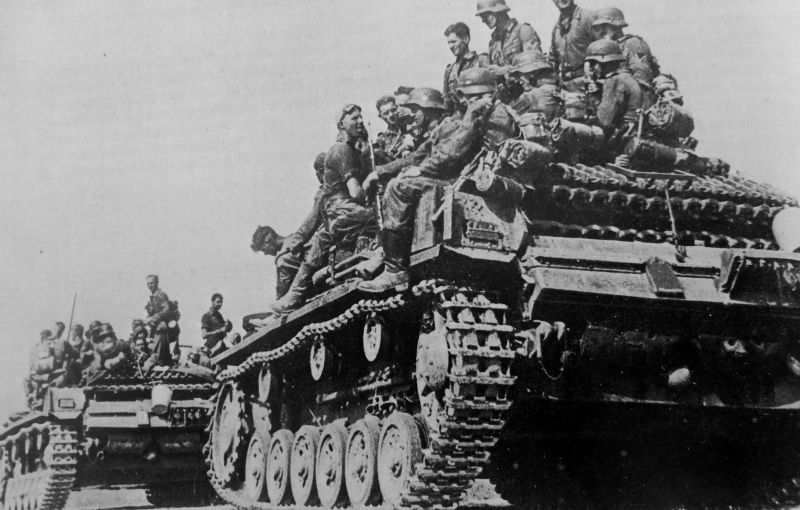
German Tanks Advancing
On February 3, 1941, at a secret meeting with the Fuhrer, which was attended by the Chief of the General Staff of the OKW and the Chief of Staff of the Wehrmacht’s operational leadership, Hitler once again instructed “… the concentration and deployment of troops according to the Barbarossa plan to mask through disinformation regarding the implementation of Operation Sea Lion and secondary operation “Marita”.
In January 1941, the transfer of German troops from west to east intensified and was carried out at an accelerated pace. Covering the concentration of troops in the areas adjacent to the southern border of the USSR, the command of the German troops explained this by the fact that all such measures were allegedly caused by the need to prevent attempts by British penetration into the Balkans. It was this alleged act on the part of England that Germany explained the need to bring its troops into Romania and Bulgaria.
February 15, 1941 Field Marshal V. Keitel Signed an order on disinformation and camouflage in preparation for an attack on the USSR during the period of concentration and deployment of German troops, where disinformation activities were divided into two stages. The first one (until about mid-April 1941) was supposed to create a false impression of the intentions of the German command, focusing on plans for the invasion of England, as well as on the preparation of Operation Marita (in the Balkans) and Sonnenblum (in North Africa). The transfer of troops for Operation Barbarossa was proposed to be portrayed as an exchange of forces between the West, Germany and the East, either as pulling up rear echelons for Operation Marita, or as preparing defenses in case of a Soviet attack. At the second stage, when it became impossible to hide the preparation, the strategic deployment of forces for Operation Barbarossa was to be portrayed as “the biggest diversion in the history of warfare”, ostensibly to divert attention from the final preparations for the invasion of England. In order to create a complete illusion of preparations for an invasion of the British Isles, the German command ordered that information about the non-existent “airborne corps” be disseminated, and in addition, topographic materials on England, German-English phrasebooks, etc., be printed in mass circulation.
The organizer of disinformation activities in the military sphere was determined by the information service, which was created in the department of military intelligence and counterintelligence. The activity of this service was controlled by Admiral V. Canaris. It was envisaged that Canaris would organize the transfer of disinformation information to the German military attaché in neutral countries and the attaché of neutral countries in Berlin, which would have to be “… fragmentary, but correspond to one general trend” – to indicate the allegedly ongoing preparations for the invasion of England.
In order to mislead the leadership of the USSR about the actions of German troops in Poland and East Prussia, the commander of Army Group “B” (from June 22, 1941 – “Center”) F. F. von Bock on March 24, 1941 ordered the construction of various fortifications along borders, supposedly intended for defense against a possible Soviet offensive. An order was given not to interfere with Soviet air reconnaissance to monitor the work being done.
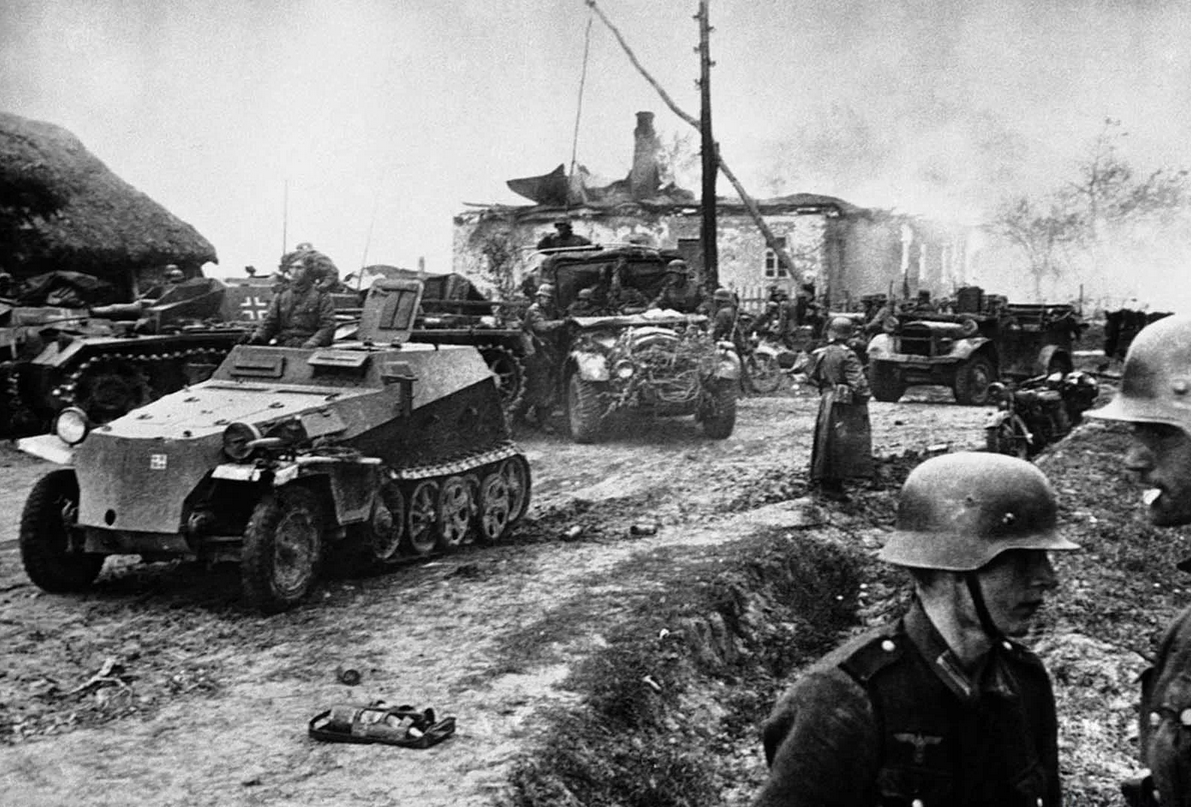
German Halftracks Attacking
Operation Marita was indeed carried out between April 6 and 24, 1941. German troops, supported by Italy and Hungary, captured Yugoslavia and Greece. As a result of this operation, Germany managed to create a strategic bridgehead to secure the southern flank on the eve of the war against the USSR. The arrival of the British Expeditionary Force in the area of hostilities did not change the situation.
On April 24, von Brauchitsch ordered Operation Highfish (Shark), the landing of German troops on the southern coast of the British Isles. In reality, this was only an imitation of the preparation of several divisions for a landing from the Atlantic coast of France. At the same time, a similar action was carried out by German troops stationed in Norway and Denmark.
On May 12, 1941, the headquarters of the operational leadership of the OKW approved new instructions on measures to carry out the second phase of disinformation. These instructions prescribed: “The second phase of disinformation of the enemy begins simultaneously with the introduction of the most compacted schedule for the movement of echelons on May 22. At this point, the efforts of the highest headquarters and other agencies involved in disinformation should be directed to an increased extent to present the concentration of forces for Operation Barbarossa as a widely conceived maneuver in order to mislead the Western adversary. Particular attention was paid to the fact that among the formations located in the east the rumor about the rear cover against Russia and “… a diversionary concentration of forces in the east” must circulate, and the troops located on the English Channel must have believed in the actual preparations for the invasion of England.Crete (Operation Mercury) was a dress rehearsal for crossing the English Channel and landing German troops on the British Isles.
The command of the Wehrmacht sought to keep the personnel of its troops in the dark about the planned operation for as long as possible. In some parts, the soldiers were told that they were going to rest before the invasion of England, in others – that the troops would be passed through Soviet territory to fight against British India.
The command of the operational leadership of the OKW strictly indicated that all efforts to misinform the enemy would be in vain if the German troops found out about the upcoming attack and spread this information throughout Germany.
According to the instructions of the OKW headquarters of May 8, 1941, the officers were to be informed about eight days before the start of hostilities, and the privates and non-commissioned officers – only in the very last days.
Strategic aerial reconnaissance
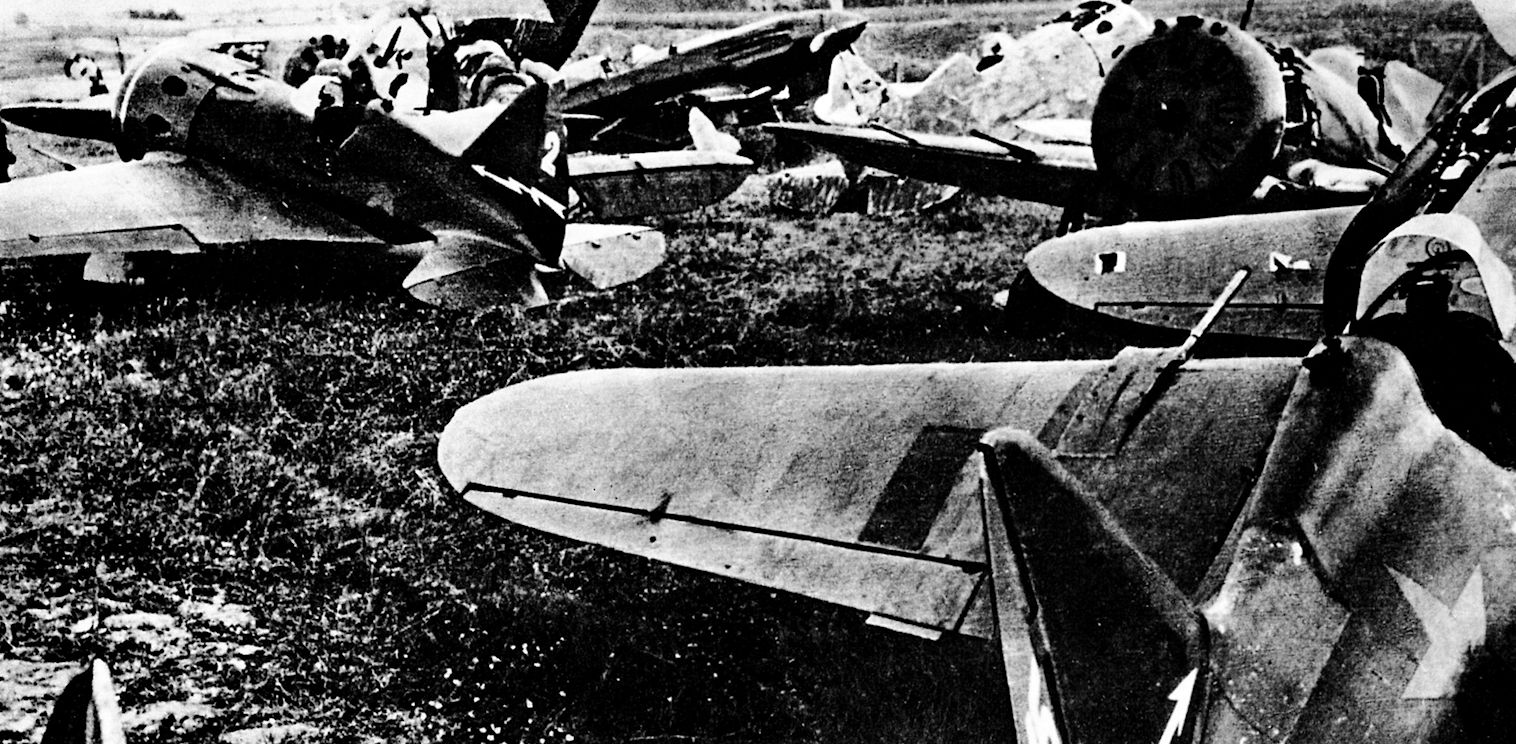
Destroyed Soviet Aircraft Operation Barbarossa
To neutralize the numerical superiority of the Soviet Air Force, the invasion plan provided for the destruction of the main part of the aviation of the Western Military District at home airfields. The decisive conditions for the success of this operation were careful planning and surprise. An important role in the preparation of the operation was played by the strategic air reconnaissance of the Luftwaffe. A special squadron was created to conduct reconnaissance – the “Reconnaissance Group of the Luftwaffe High Command” (German: Aufkl ungsgruppe des Oberbefehlshabers der Luftwaffe – Aufkl. St. (F) / Ob. d. L), the so-called “Rovel Group”. The group was armed with a fleet of high-altitude bombers (Do 215 B-2, He 111 Bombers ,Ju 88, Ju 86 P), modified for aerial photography. Flying at altitudes inaccessible to Soviet fighters, the group carried out an extensive amount of photography of strategic facilities in the western part of the USSR, including military airfields. Part of the sorties were carried out to great depths, up to the cities of Ufa, Baku and Gorky. It was these images that ensured the high efficiency of the first strike on Soviet airfields.
Operation Barbarossa Balance of power
Germany and allies
To attack the USSR by June 22, 1941, four army groups were created with a total of 157 divisions and 12 brigades. Taking into account the strategic reserve, the grouping for operations in the East consisted of 183 divisions and 13 brigades.
- Army Group North (commanded by Field Marshal Wilhelm von Leeb) was deployed in East Prussia, on the front from Memel to Goldap. It included the 16th Army, the 18th Army and the 4th Panzer Group – a total of 29 divisions (including 3 tank and 3 motorized). The offensive was supported by the 1st Air Fleet, which had 1070 combat aircraft. The task of the Army Group “North” included the defeat of Soviet troops in the Baltic states, the capture of Leningrad and ports on the Baltic Sea, including Tallinn andKronstadt.
- Army Group Center (commander – Field Marshal Fedor von Bock) occupied the front from Goldap to Vlodava. It included the 4th Army, 9th Army, 2nd Panzer Group and 3rd Panzer Group – a total of 50 divisions (including 9 tank and 6 motorized) and 1 brigade. The offensive was supported by the 2nd Air Fleet (1680 combat aircraft). Army Group Center was tasked with cutting the strategic front of the Soviet defense, encircling and destroying the troops of the Red Army in Belarus and developing an offensive in the Moscow direction.
- Army Group “South” (commander – Field Marshal Gerd von Rundstedt), which was operationally subordinate to the Command of the Romanian Land Forces, occupied the front from Lublin to the mouth of the Danube. It included the 6th Army, 11th Army, 17th Army, 4th Romanian Army, 1st Panzer Group – a total of 57 divisions (including 9 tank and motorized) and 9 brigades (including 2 motorized). The offensive was supported by the 4th Air Fleet (800 combat aircraft) and the Romanian Air Force (500 aircraft). Army Group “South” had the task of destroying Soviet troops in the Right-Bank Ukraine, go to the Dnieper and subsequently develop an offensive east of the Dnieper.
- The German-Finnish group of troops (commander – Field Marshal Karl Gustav Emil Mannerheim) occupied the front along the Soviet-Finnish border. It included: Army “Norway” (High Command of the Wehrmacht in Finland), Finnish Army (Finland), Karelian Army (Finland) – a total of 20 divisions (including 1 motorized) and 3 brigades. This group of troops had the task, going on the offensive later than the rest of the army groups, to defeat the opposing Soviet forces, blockade Leningrad, capture Murmansk, leading a further offensive on Arkhangelsk.
- Reserves of the High Command of the German Land Forces. By July 4, 1941, it was planned to concentrate 13 divisions and 1 brigade in the East, after July 4, 1941 – 11 divisions in the East and two in Germany.
USSR
In the USSR, on the basis of the military districts located on the western border, according to the decision of the Politburo of the Central Committee of the All-Union Communist Party of Bolsheviks of June 21, 1941, 4 fronts were created. On June 24, 1941, the Northern Front was created. According to a certificate compiled on the eve of the war by the Deputy Chief of the General Staff of the Red Army, General Vatutin, in total there were 303 divisions in the ground forces, of which 237 divisions were in the grouping for operations in the West (of which 51 were tank and 25 motorized). The grouping for operations in the West was lined up in three strategic echelons.
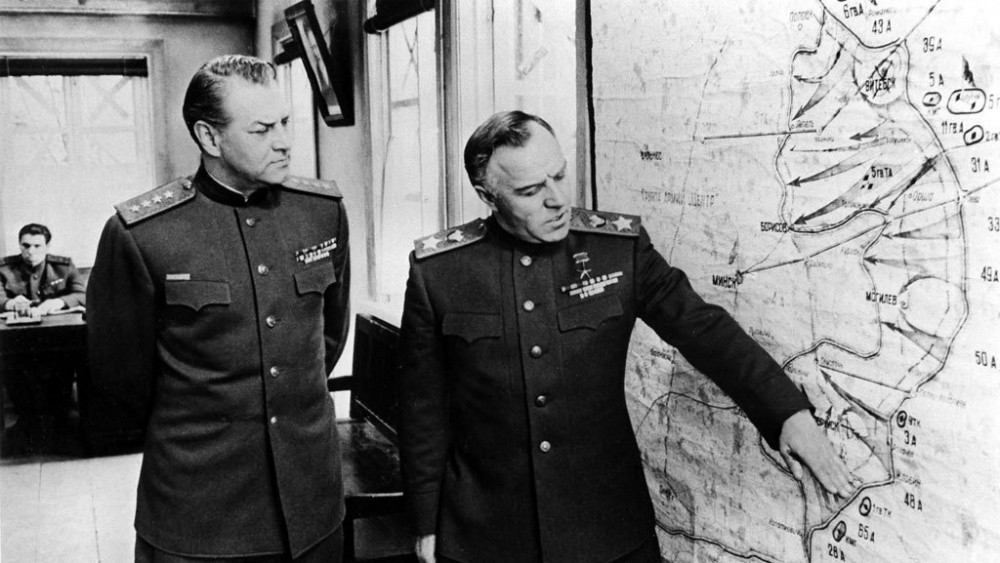
Soviet Generals
- The Northwestern Front (commanded by Colonel General F. I. Kuznetsov) was created in the Baltic. It included the 8th Army (Major General P.P. Sobennikov), the 11th Army (Lieutenant General V.I. Morozov) and the 27th Army (Major General N.E. Berzarin) – a total of 34 divisions (of which 6 are armored and motorized). The front was supported by the Air Force of the North-Western Front.
- The Western Front (commander General of the Army D. G. Pavlov) was created in Belarus. It included the 3rd Army (Lieutenant General V.I. Kuznetsov), the 4th Army (Major General A.A. Korobkov), the 10th Army (Major General K.D. Golubev) and the 13th I am an army (lieutenant general P. M. Filatov) – a total of 45 divisions (of which 20 are tank and motorized). The front was supported by the Air Force of the Western Front.
- The Southwestern Front (commanded by Colonel-General M.P. Kirponos) was created in Western Ukraine. It included the 5th Army (Major General of Tank Troops M.I. Potapov), 6th Army (Lieutenant General I.N. Muzychenko), 12th Army (Major General P.G. Ponedelin) and 26th Army Lieutenant General F. Ya. Kostenko) – a total of 45 divisions (of which 18 are tank and motorized). The front was supported by the Air Force of the Southwestern Front.
- The Southern Front (commander General of the Army I. V. Tyulenev) was created in Moldova and Southern Ukraine. It included the 9th Army (Colonel General Ya. T. Cherevichenko) and the 18th Army (Lieutenant General A. K. Smirnov) – a total of 26 divisions (of which 9 were tank and motorized). The front was supported by the Air Force of the Southern Front.
- The Northern Front (commanded by Lieutenant General M. M. Popov) was created on the basis of the Leningrad Military District. It included the 7th Army (Lieutenant General F. D. Gorelenko), the 14th Army (Lieutenant General V. A. Frolov), the 23 Army (Lieutenant General P. S. Pshennikov) – a total of 22 divisions and 1 brigade. The front was supported by the Air Force of the Northern Front
- The Baltic Fleet (commanded by Admiral V. F. Tributs) was stationed in the Baltic Sea. It included 2 battleships, 2 cruisers, 2 destroyer leaders, 19 destroyers, 65 submarines, 48 torpedo boats and other ships, and 656 aircraft.
- The Black Sea Fleet (commander Vice Admiral F. S. Oktyabrsky) was stationed in the Black Sea. It included 1 battleship, 5 light cruisers, 16 destroyer leaders, 47 submarines, 2 brigades of torpedo boats, several divisions of minesweepers, patrol and anti-submarine boats, over 600 aircraft.
In late May – early June 1941 (as in the summer of 1940), partial mobilization was carried out under the guise of reserve training camps, which made it possible to call up over 800 thousand people used to replenish divisions located mainly in the west of the country. From mid-May, four armies (16th, 19th, 21st and 22nd) and one rifle corps began to advance from the internal military districts to the line of the Dnieper and Western Dvina rivers. From mid-June, a covert regrouping of the formations of the westernmost border districts began: under the guise of reaching the camps, more than half of the divisions that made up the reserve of these districts were set in motion. From June 14 to June 19, the commands of the western border districts received instructions to withdraw front-line departments to field command posts. Since mid-June, vacations for personnel have been canceled.
56 divisions and 2 brigades were deployed in the first echelons of the covering armies, 52 divisions in the second echelons, and 62 divisions in the district reserve. On sections of the border that ran along natural boundaries (mountains, rivers), the cover zone for one division reached 100-120 kilometers, in the main operational directions it was 25-30 kilometers. The second echelons of the covering armies and reserves were located 25-75 kilometers from the border.
At the same time, the General Staff of the Red Army categorically suppressed any attempts by the commanders of the western border districts to strengthen the defense by occupying the foreground of the border fortified areas. Only on the night of June 22 did the Soviet military districts receive a directive on the transition to combat readiness, however, it reached many headquarters after the attack. Stalin allowed People’s Commissar of Defense Timoshenko and Chief of the General Staff Zhukov to send this directive after the Soviet border guards had a German sergeant major- a defector who warned of an invasion scheduled for the next morning. Soon another defector appeared with the same message, Corporal Alfred Liskov).
In terms of the number of tanks, the Soviet troops of the western military districts exceeded the forces of Germany and its allies intended for the invasion by 3.6 times, in terms of the number of aircraft – by 2.2 times. The Soviet troops had quite numerous new tanks KV-1 Tanks, KV-2 and T-34, which the German troops had no equivalent tanks.
However, the Soviet troops were not mobilized and did not have deployed rear structures. Of the 77 divisions of the covering troops in the first hours of the war, only 38 incompletely mobilized divisions could resist, and the rest of the troops were either in places of permanent deployment, or in camps, or on the march. At the same time, the enemy immediately launched 103 divisions into the offensive and created powerful groupings in the directions of the main attacks.
Operation Barbarossa – First phase; Invasion, Border battles (June 22 – July 10, 1941)
Start of the invasion of the Soviet Union
Hitler’s appeal to the “Soldiers of the Eastern Front” was read by the commanders only on the night of June 22, 1941, when the Third Reich had already declared war on the USSR. On the same day, Italy declared war on the USSR (Italian troops began hostilities on July 20, 1941) and Romania, on June 23 – Slovakia, on June 27 – Hungary. The German invasion took the Soviet forces by surprise; on the very first day, a significant part of ammunition, fuel and military equipment was destroyed; the Germans managed to ensure complete air supremacy (about 1200 aircraft were disabled).
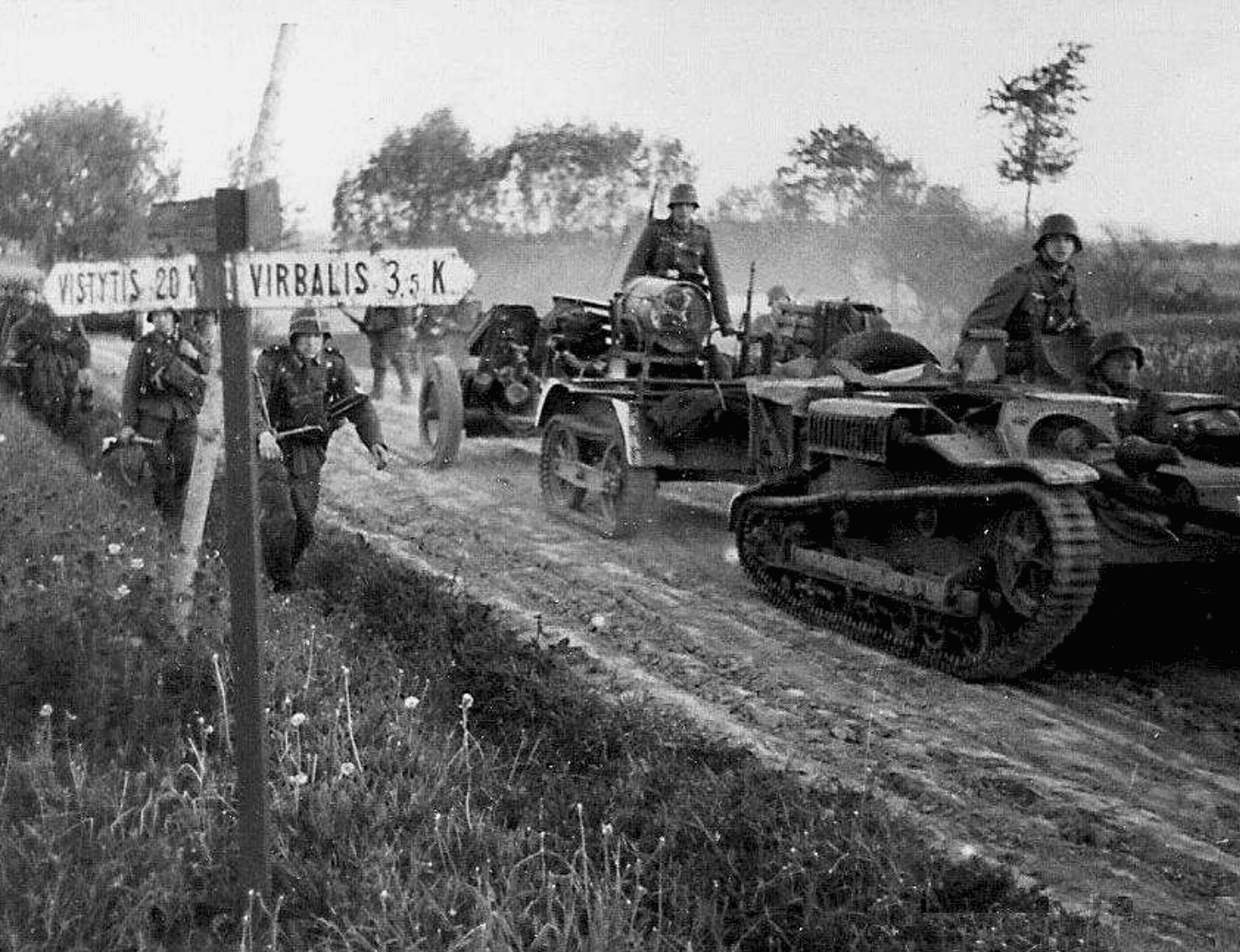
German Advance 2
In the early morning of June 22, at 3 o’clock, the first Wehrmacht sappers moved to Soviet territory, and at 4 o’clock, after powerful artillery preparation, the advance units began to invade, followed by the main forces. The German offensive unfolded on the front with a length of 3 thousand km, in three directions – to Leningrad, Moscow and Kiev. Submarines were deployed on the sea lanes of the Baltic and Black Seas, and minefields were laid. The Soviet command was unable to soberly assess the position of its troops. Chief Military CouncilOn the evening of June 22, he sent directives to the Military Councils of the fronts, demanding that decisive counterattacks be launched on the enemy groupings that had broken through from the morning of June 23. As a result of unsuccessful counterattacks, the already difficult situation of the Soviet troops worsened even more.
On June 21-25, the naval and air forces of Germany acted from the territory of Finland against the USSR. On June 22, 1941, in response to the occupation of the demilitarized zone of the Aland Islands by Finnish troops, Finnish troops were bombed by Soviet aircraft. On June 25, the forces of the Soviet air fleet launched an airstrike on 18 Finnish airfields involved in military operations and several settlements. On the same day, the Finnish government declared that the country was at war with the USSR, and German and Finnish troops invaded Karelia and the Arctic, increasing the front line and endangering Leningrad and the Murmansk railway. Fighting here, however, soon turned into a positional war and did not affect the general state of affairs on the Soviet-German front.
North direction
At first, not one, but two tank groups acted against the Soviet North-Western Front :
- Army Group North operated in the Leningrad direction, and its main strike force, the 4th Panzer Group, advanced on Daugavpils.
- The 3rd Panzer Group of the Army Group “Center” was advancing in the Vilnius direction.
On June 22, 1941, supporters of the Lithuanian Front of Activists raised an armed uprising against the Soviet regime. The rebels took control of strategically important objects and entire cities, attacked the retreating units of the Red Army and killed Soviet activists.
An attempt by the command of the North-Western Front to launch a counterattack with the forces of two mechanized corps (almost 1000 tanks) near the town of Raseiniai ended in complete failure, and on June 25 a decision was made to withdraw troops to the line of the Western Dvina.
But already on June 26, the German 4th Panzer Group crossed the Western Dvina near Daugavpils (E. von Manstein ‘s 56th motorized corps), on July 2 – at Jekabpils (G. Reinhardt ‘s 41st motorized corps). The infantry divisions followed the motorized corps. On June 27, units of the Red Army left Libau. On July 1, the German 18th Army occupied Riga and withdrew into southern Estonia.
Meanwhile, the 3rd Panzer Group of the Army Group Center, having overcome the resistance of the Soviet troops near Alytus, took Vilnius on June 24, turned to the southeast and entered the rear of the Soviet Western Front.
Central direction
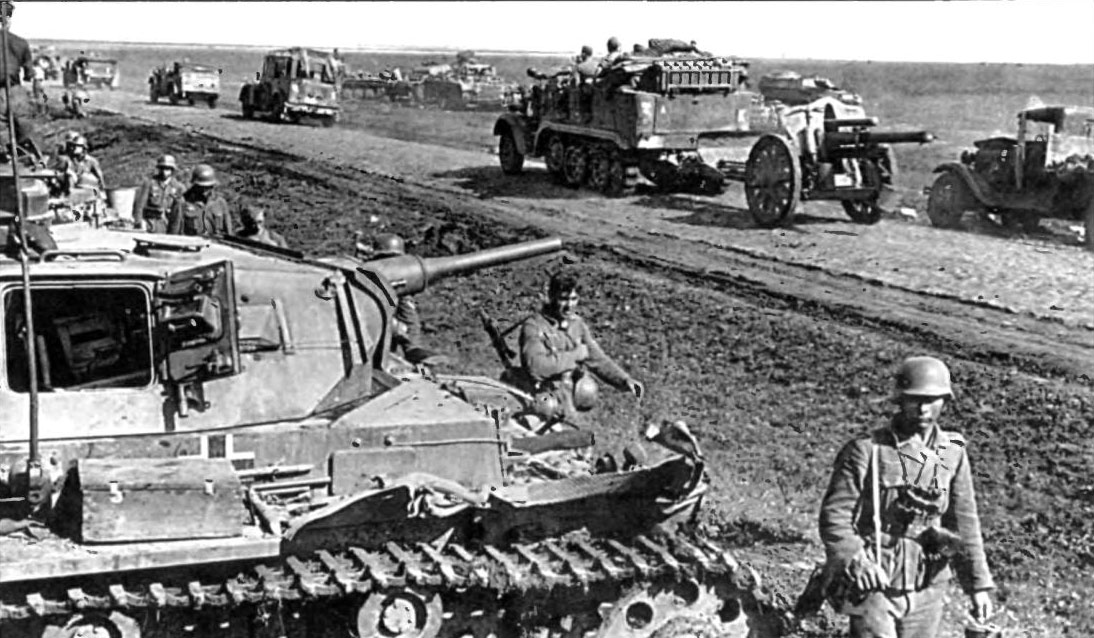
Panzer Tanks Operation Barbarossa
A difficult situation has developed on the Western Front. On the very first day, the flank armies of the Western Front (the 3rd Army in the Grodno region and the 4th Army in the Brest region) suffered heavy losses. The counterattacks of the mechanized corps of the Western Front on June 23-25 ended in failure. The German 3rd Panzer Group, having overcome the resistance of the Soviet troops in Lithuania and developing an offensive in the Vilnius direction, bypassed the 3rd and 10th Armies from the north, and the 2nd Panzer Group, leaving the Brest Fortress in the rear, broke through to Baranovichi and bypassed them from the south. June 28, the Germans took the capital of Belarusand closed the encirclement ring, in which the main forces of the Western Front found themselves.
On June 30, the commander of the Western Front, General of the Army D. G. Pavlov was removed from command; later, by decision of the military tribunal, he, along with other generals and officers of the headquarters of the Western Front, was shot. The troops of the Western Front were first led by Lieutenant General A. I. Eremenko (June 30), then People’s Commissar of Defense Marshal S. K. Timoshenko (appointed on July 2, took office on July 4). Due to the fact that the main forces of the Western Front were defeated in the Battle of Belostok-Minsk, on July 2, the troops of the Second Strategic Echelon were transferred to the Western Front.
In early July, Wehrmacht motorized corps overcame the line of Soviet defense on the Berezina River and rushed to the line of the Western Dvina and Dnieper rivers, but unexpectedly ran into the troops of the restored Western Front (in the first echelon of the 22nd, 20th and 21st Armies). On July 6, 1941, the Soviet command launched an offensive in the Lepel direction. During the heated tank battle on July 6-9 between Orsha and Vitebsk, in which more than 1600 tanks participated from the Soviet side, and from the German side up to 700 units, the German troops defeated the Soviet troops and took Vitebsk on July 9. The surviving Soviet units withdrew to the area between Vitebsk and Orsha. German troops took up starting positions for the subsequent offensive in the area of Polotsk, Vitebsk, south of Orsha, and also north and south of Mogilev.
South direction
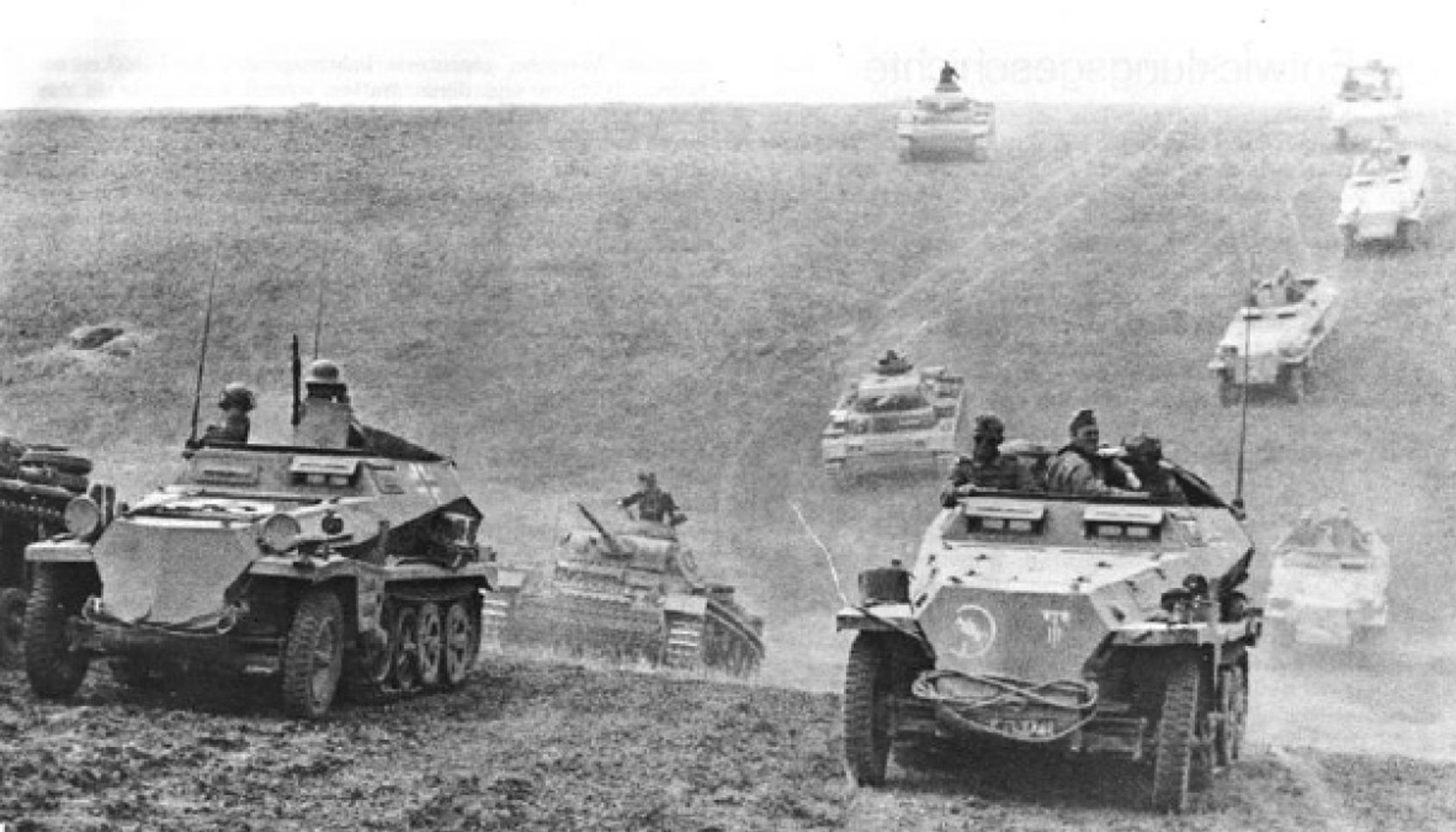
German Halftracks Attacking Operation Barbarossa
The fighting of the Wehrmacht in the south, where the most powerful grouping of the Red Army was located, was not so successful. On June 23-25, the aviation of the Black Sea Fleet launched bombing attacks on the Romanian cities of Sulina and Constanta; On June 26, Constanta was attacked by ships of the Black Sea Fleet together with aviation. In an effort to stop the offensive of the 1st Panzer Group, the command of the South-Western Front launched a counterattack with the forces of six mechanized corps (about 2500 tanks). During a major tank battle in the Dubno-Lutsk-Brody areaSoviet troops were unable to defeat the enemy and suffered heavy losses, but prevented the Germans from making a strategic breakthrough and cutting off the Lvov grouping (6th and 26th armies) from the rest of the forces. By July 1, the troops of the Southwestern Front withdrew to the fortified line Korosten – Novograd-Volynsky – Proskurov. In early July, the Germans broke through the right wing of the front near Novograd-Volynsky and captured Berdichev and Zhitomir, but thanks to Soviet counterattacks, their further advance was stopped.
At the junction of the Southwestern and Southern fronts, on July 2, the German-Romanian troops crossed the Prut and rushed to Mogilev-Podolsky. By July 10 they reached Dniester.
Results of border battles in Operation Barbarossa
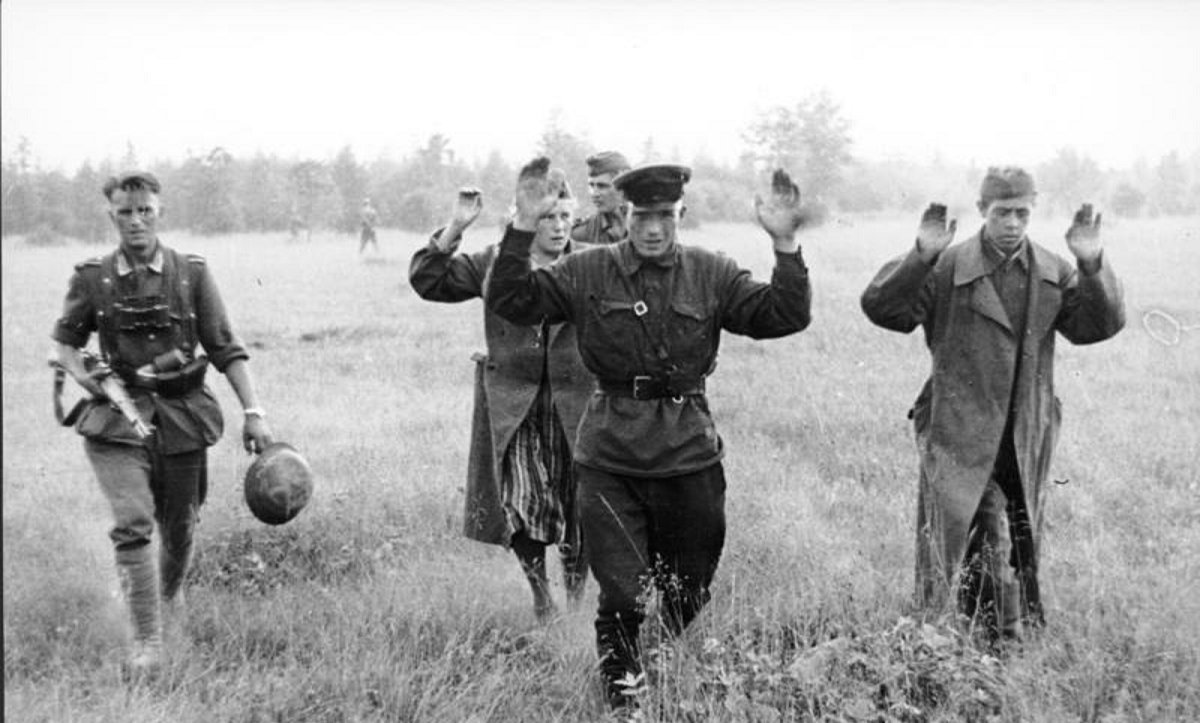
Soviet POWS
As a result of border battles, the Wehrmacht inflicted a heavy defeat on the Red Army.
Summing up the results of the first phase of Operation Barbarossa, on July 3, 1941, the head of the German General Staff of the Ground Forces F. Halder wrote in his diary:
In general, it can already be said that the task of defeating the main forces of the Russian land army in front of the Western Dvina and the Dnieper has been completed… Therefore, it will not be an exaggeration to say that the campaign against Russia was won within 14 days. Of course, it’s not finished yet. The vast extent of the territory and the stubborn resistance of the enemy, using all means, will fetter our forces for many weeks to come…. When we cross the Western Dvina and the Dnieper, it will be not so much about defeating the enemy’s armed forces, but about taking away the enemy’s industrial areas from the enemy and not giving him the opportunity, using the gigantic power of his industry and inexhaustible human resources, to create new armed strength. As soon as the war in the east moves from the phase of defeating the enemy’s armed forces to the phase of economic suppression of the enemy,
In the diary of the Supreme High Command of the Wehrmacht for July 4, 1941, Hitler stated that the Soviet Union had already practically lost the war:
Fuhrer: “I always try to put myself in the position of the enemy. In fact, he already lost the war. It’s good that we defeated the Russian tank and air forces at the very beginning. The Russians will not be able to restore them anymore.”
– cited according to the “Military Historical Journal”, 1966, No. 1, p. 74, 77
In about three weeks of the war, German troops occupied the entire Baltic, Belarus, a significant part of Ukraine and Moldova. In the northwestern and southwestern directions, the enemy invaded the territory of the USSR up to 500 km, in the west – up to 600 km. The average rate of advance of the German troops was from 15 to 30 km per day. In border battles and in subsequent defensive operations, 28 Soviet divisions were completely defeated (12 rifle, 10 tank, 4 motorized, 2 cavalry), more than 72 divisions suffered losses in people and equipment of 50% or more. The total losses of the Soviet troops by July 30 amounted to 651,065 people. (irrevocable – 447,015 people, sanitary – 204,050 people). According to incomplete data from the fronts and headquarters, long-range bomber aviation lost 3468 aircraft during this time, the Soviet troops lost about 9.5 thousand guns, 12 thousand. At the same time, many tanks were not destroyed in battle, but abandoned or blown up during the retreat due to breakdowns and lack of fuel. As a result of the huge losses of tanks and the subsequent evacuation of tank factories from Leningrad and Kharkov, by the end of 1941, the Soviet troops experienced an acute shortage of tanks.
200 warehouses were lost (52% of the district warehouses and the warehouses of the People’s Commissariat of Defense on the territory of the border districts). This led to an acute shortage of ammunition, fuel and food in the Soviet units and formations. The German army got significant trophies. Thus, on July 1, Halder recorded that about one-third of the fuel consumption was covered by trophy reserves.
By the beginning of the battle for Moscow, Soviet troops lost 1.8 million people only as prisoners.
At the same time, Halder admitted that the Soviet troops resisted stubbornly. On June 29 he wrote:
Information from the front confirms that the Russians are fighting everywhere to the last man. They surrender only in places, primarily where there is a large percentage of Mongolian peoples in the troops (in front of the front of the 6th and 9th armies).
It is striking that when artillery batteries, etc., are captured, only a few are taken prisoner… The stubborn resistance of the Russians forces us to fight in accordance with all the rules of our combat regulations. In Poland and in the West, we could afford certain liberties and deviations from the statutory principles; this is now unacceptable.
By mid-July, German troops had lost about 100 thousand people (the same as in the previous two years of the World War), over 1 thousand aircraft and up to 1.5 thousand tanks.
On the other hand, K. Rokossovsky wrote:
The unexpected blow inflicted by the enemy with huge forces and its rapid advance into the interior of the territory for some time stunned our unprepared troops. They were shocked. It took a long time to get them out of this state. Confusion was also facilitated by reasons of a military and political nature, relating to a time remote from the start of the war.
The combination of important reasons and circumstances to a certain extent lowered the morale of the troops, weakened their stability and stubbornness for a certain period, unbalanced especially those units that entered the battle in a disorganized manner. And other unstable elements have completely lost faith in their own strength, in the possibility of resisting a formidable enemy.According to official data, from June 22, 1941 to October 10, 1941, 647,364 people were detained by the NKVD on suspicion of desertion; most of them were returned to the front, but more than 10,000 people were shot, of which more than 3,000 were executed in public.
Operation Barbarossa – Soviet troops in border battles
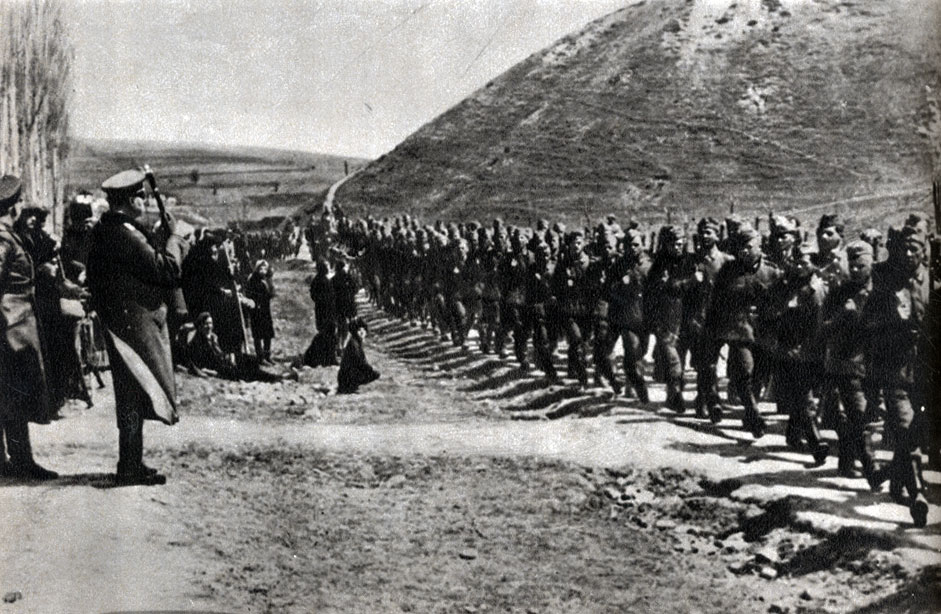
German Troops Operation Barbarassoa
- Insufficient professionalism of the command staff, due to the fact that many senior commanders were recently appointed to their positions and did not have the necessary experience. This was the result of mass repressions of the highest commanding staff in 1937-1938].Former Chief of the General Staff G.K. Zhukov recalled: “Until 1936, that is, before the mass arrests of major military figures of the country and commanders of higher formations, both theoretically and practically, serious attention was paid to the operational-strategic interaction of the branches of the armed forces; the most important problematic issues were considered and solved, in the period of 1936-1939, This most important strategic work was at a standstill, simply put, there was no one to carry it out, since almost everything serious and deeply thinking suffered a tragic fate. This most important state work revived somewhat after the Soviet-Finnish war, in 1940 and at the beginning of 1941, that is, immediately before the sudden attack of fascist Germany on the Soviet Union“. A significant part of the troops of the Soviet border western military districts was concentrated in the Bialystok and Lvov ledges near the border, which led to the fact that even before the start of the war they were actually semi-surrounded by the enemy. In these ledges was the main striking force of the districts – mechanized corps. In a number of cases, the initial areas of concentration of units and formations for occupying defense were in the enemy’s visibility zone and could be hit by his artillery fire. This deployment of troops was due to the fact that the Soviet command proceeded from the offensive strategy of a future war. Huge stocks of ammunition and fuel were also concentrated in the Bialystok and Lvov ledges. Here is what G.K. Zhukov wrote about this : “On the eve of the war, the 3rd, 4th and 10th armies of the Western District were located in the Bialystok ledge, curved towards the enemy, the 10th army occupied the most disadvantageous location. Such an operational configuration of troops created a threat of deep coverage and encirclement from Grodno and Brest by attacking the flanks. Meanwhile, the deployment of front troops in the Grodno-Suvalkovsky and Brest directions was not deep enough and powerful enough to prevent a breakthrough here and the coverage of the Bialystok grouping. This erroneous disposition of troops, admitted in 1940, was not eliminated until the war itself.
- Fortified areas along the line of the new western border (the so-called Molotov Line) were built directly on the border itself, and often without the required foreground. By June 1941, their construction and armament had not been completed. Meanwhile, part of the armament was withdrawn from the fortified areas along the old border (Stalin Line) to equip the fortified areas on the new border, which prevented the old fortified areas from being reactivated when the enemy approached.
- The Soviet command, proceeding from the offensive strategy of a future war, did not pay due attention to the development of defensive operations. G.K. Zhukov recalled: “The training of troops in defensive actions, oncoming battles, and retreat actions rarely went beyond the tactical framework. I do not know of a single operational-strategic event where the defense would be played out or worked out on a large operational-strategic scale, where the defense would counteract a deep breakthrough of large armored groupings interacting with large air forces, and as a result, our headquarters and commanders of an operational scale on the eve wars were not trained in the effective conduct of defense on an operational-strategic scale, not to mention the fact that such defensive operations were not developed at the headquarters of the border districts and the General Staff as a possible option “.
- The enemy managed to achieve almost complete operational and tactical surprise of his offensive (in particular, many artillery and anti-aircraft units of the border divisions were in training camps and training grounds on June 22, many commanders were on vacation), which led to heavy losses due to the first fire strike, and the rapid advance of strike groups deep into the Soviet defenses already in the first hours of the offensive.
“How long will Russia last?”
Time magazine in an editorial “How long will Russia last?” dated June 30, 1941 wrote:
“The question of whether the battle for Russia will become the most important battle in the history of mankind is not decided by German soldiers. The answer to that depends on the Russians.”
— Time Magazine, June 30, 1941
On June 14, the US Joint Intelligence Committee concluded that it would take Germany at most six weeks to take Moscow. Also V. I. Dashichev mentions the report of the US Secretary of War G. L. Stimson presented on June 23 to Roosevelt. It assumed that Germany would crush the Soviet Union “in at least a month, and possibly a maximum of three” and therefore in the war of Western countries against Germany and Japan, the Soviet Union would be only a temporary ally, like Poland in 1939 or France in 1940 According to David Glantz:
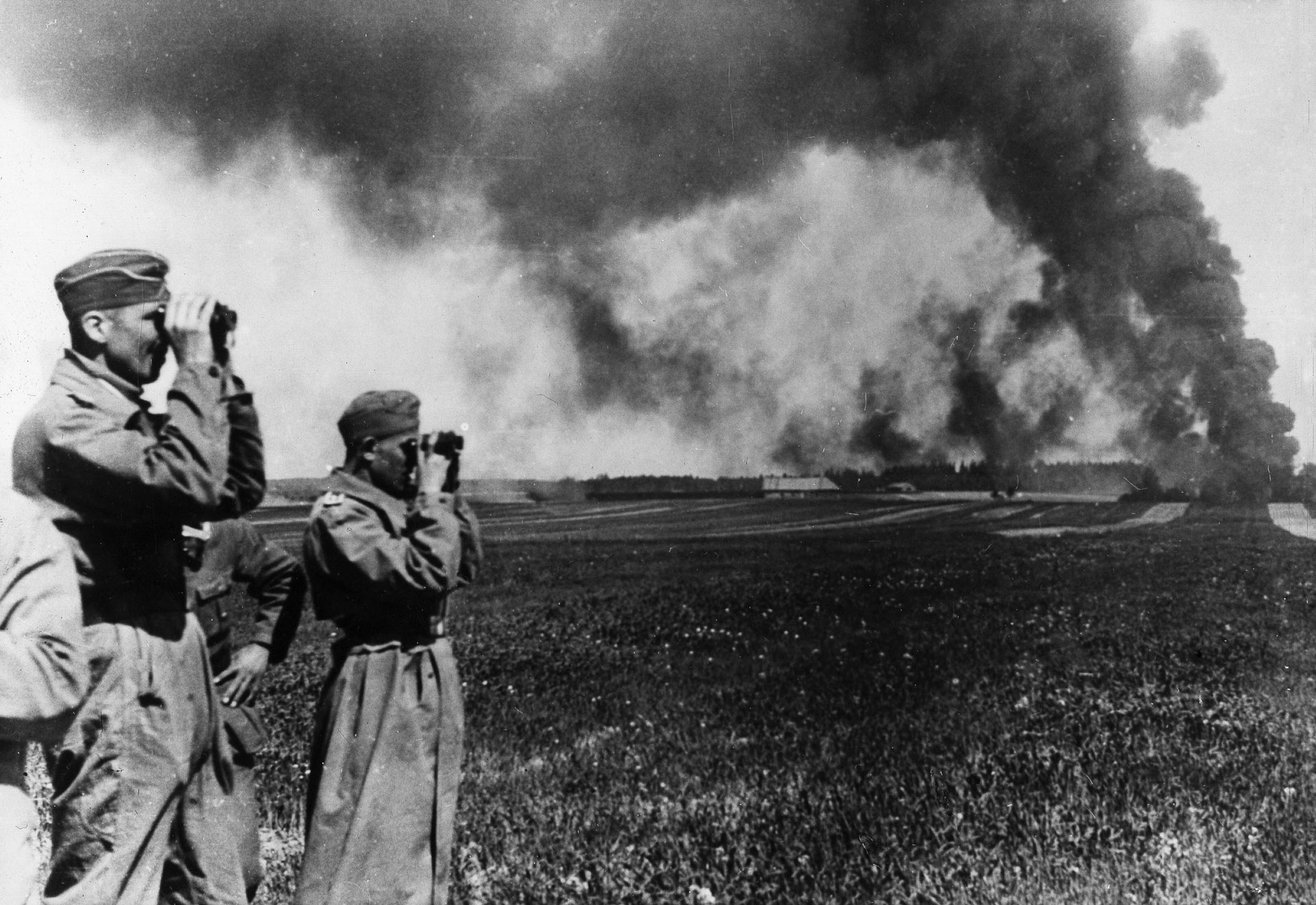
German Officer Watching the Advance
Capturing Smolensk on 16 July, von Bock’s forces advanced some 500 km in 25 days of fighting, breaking all the speed records set by the Wehrmacht during campaigns in Europe. And thus, only 300 km remained to the main goal of the operation – Moscow. That is, based on the previous pace of advance – 20 km per day and 140 km per week, taking into account pauses for rest, repair of equipment and replenishment of supplies, von Bock was separated from Moscow by 2-3 weeks.
– Glantz D. The collapse of the Barbarossa plan. Confrontation near Smolensk. T. 2. 2011.
At the end of July 1941, US presidential adviser G. Hopkins traveled to Moscow, as a result of which the United States concluded that there were no defeatist moods in the USSR and the expediency of helping him.
Support for the USSR by the allies in the first months of the war
The policy of the British government was also influenced by skeptics, confident that “the Soviet Union in the war with Germany will not last long.” In their calculations of how much the Soviet resistance would delay the landing of the Wehrmacht on the British Isles, the British Chiefs of Staff predicted:
“No more than eight weeks”
– given by Erickson J., Dilks D. Barbarossa. The Axis and the Allies. P. 103.
Before the start of Operation Typhoon (October 1, 1941), only the Arctic convoy Dervish arrived at the port of Arkhangelsk on August 31, 1941.
- Prior to this, on July 12, 1941, a Soviet-British agreement was concluded on joint actions in the war against Germany, where it was stated that “during the continuation of this war, they will neither negotiate nor conclude an armistice or peace treaty, except by mutual consent”.
- However, the signing of the Anglo-Soviet agreement on trade, credit and clearing, under which England provided a loan in the amount of 10 million pounds, took place only on August 16, 1941. As a result, the Dervish convoy was the first before the start of Operation Typhoon, and the next one (Convoy PQ-1) arrived in Arkhangelsk only on October 11, 1941, and in the absence of Kriegsmarine attacks.
- An important factor was the position of the English public. As noted by British historians D. Erickson and D. Dilks:
… The Foreign Office, belatedly recognizing the extent of the military threat to the Soviet Union, was forced to consider the likelihood of a joint struggle and the “unpleasant reality” of the growing huge sympathy for the Russians
—
Operation Barbarossa – Second phase; The offensive of the Germans along the entire front (July 10 – August 1941)
North direction
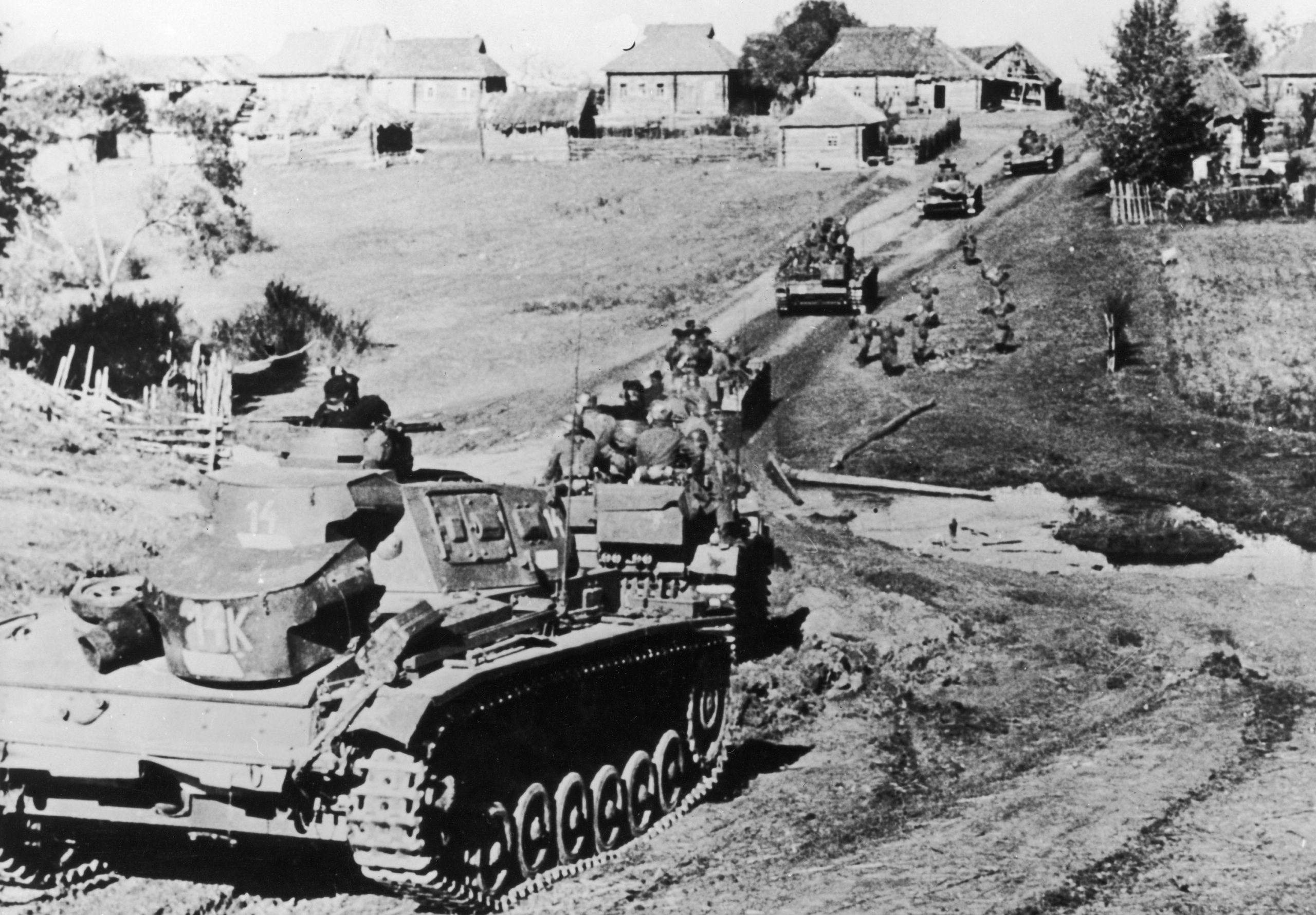
German Advance Operation Barbarossa
On July 2, Army Group North continued its offensive, its 4th Panzer Group advanced in the direction of Rezekne, Ostrov, Pskov. On July 4, the 41st motorized corps occupied Ostrov, on July 9 – Pskov.
On July 10, Army Group North continued its offensive in the Leningrad (4th Panzer Group) and Tallinn (18th Army) directions. However, the German 56th motorized corps was stopped by a counterattack by the Soviet 11th Army near Soltsy. Under these conditions, the German command on July 19 suspended the offensive of the 4th Panzer Group for almost three weeks until the formations of the 18th and 16th armies approached. Only at the end of July did the Germans reach the line of the rivers Narva, Luga and Mshaga.
On August 7, German troops broke through the defenses of the 8th Army and reached the coast of the Gulf of Finland in the Kunda region. The 8th Army was divided into two parts: the 11th Rifle Corps withdrew to Narva, and the 10th Rifle Corps to Tallinn, where, together with the sailors of the Baltic Fleet, they defended the city until August 28.
On August 8, the offensive of Army Group North resumed on Leningrad in the direction of Krasnogvardeysk, on August 10 – in the Luga region and in the Novgorod-Chudovsky direction. On August 12, the Soviet command launched a counterattack near Staraya Russa, but on August 19, the enemy retaliated and defeated the Soviet troops.
August 19, German troops occupied Novgorod, August 20 – Chudovo. On August 23, fighting began for Oranienbaum; On September 1, the Germans were stopped southeast of Koporye near the river. Funnel.
Attack on Leningrad
To reinforce Army Group North, the 3rd Panzer Group of G. Hoth (39th and 57th motorized corps) and the 8th Air Corps of W. von Richthofen were transferred to it.
At the end of August, German troops launched a new offensive against Leningrad. On August 25, the 39th motorized corps took Lyuban, on August 30 went to the Neva and cut off the railway communication with the city, on September 8 took Shlisselburg and closed the blockade around Leningrad.
However, having decided to conduct Operation Typhoon, A. Hitler ordered that most of the mobile formations and the 8th Air Corps be released no later than September 15 to participate in the attack on Moscow.
After the Soviet troops abandoned Tallinn, the Moonsund archipelago found itself in the deep rear of the German troops. On September 8, they launched a landing operation to capture it. The islands were captured by 22 October.
By the beginning of September, Hitler came to the conclusion that Leningrad was becoming a secondary goal, and forces should be concentrated in the Moscow direction.
On September 12, Hitler canceled the assault on the city after receiving a categorical refusal from Mannerheim to cross the border agreed with Lenin on the Karelian Isthmus (Weisung Nr.35. 09/06/1941) (For further hostilities in the Leningrad direction, see Siege of Leningrad.)
On November 7, the Germans continued their offensive in a northerly direction. The railroads were cut, through which food was delivered to the besieged Leningrad through Lake Ladoga. German troops occupied Tikhvin. There was a threat of a breakthrough by German troops to the rear and encirclement of the 7th separate army, which was defending the lines on the Svir River. However, already on November 11, the 52nd Army launched a counterattack on the Wehrmacht troops, who occupied Malaya Vishera. During the unfolding battles, the Malaya Visherskaya group of German troops suffered a serious defeat. Her forces were driven back from the city across the Bolshaya Vishera River.
Central Direction
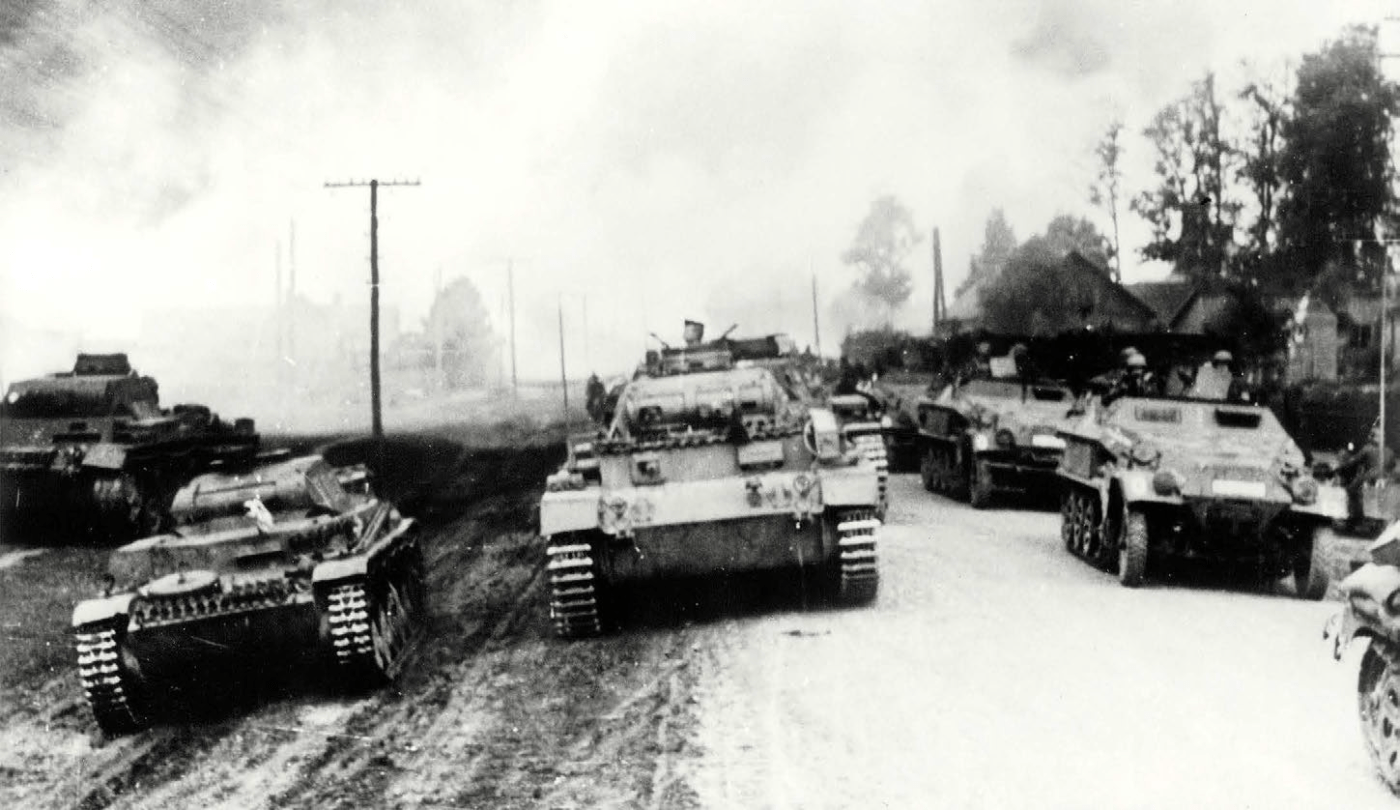
German Tanks Advancing Operation Barbarossa
On July 10-12, 1941, Army Group Center launched a new offensive in the Moscow direction. The 2nd Panzer Group crossed the Dnieper south of Orsha, and the 3rd Panzer Group struck from the direction of Vitebsk. On July 16, German troops entered Smolensk, while three Soviet armies (19th, 20th and 16th) were surrounded. By August 5, the fighting in the Smolensk “cauldron” was over, the remnants of the troops of the 16th and 20th armies crossed the Dnieper; 310 thousand people were taken prisoner.
On the northern flank of the Soviet Western Front, German troops captured Nevel (July 16), but then they fought for Velikiye Luki for a whole month. Big problems for the enemy also arose on the southern flank of the central sector of the Soviet-German front: here the Soviet troops of the 21st Army launched an offensive in the Bobruisk direction. Despite the fact that the Soviet troops failed to capture Bobruisk, they pinned down a significant number of divisions of the German 2nd Field Army and a third of the 2nd Panzer Group.
Thus, taking into account two large groupings of Soviet troops on the flanks and incessant attacks along the front, the German Army Group Center could not resume the attack on Moscow. On July 30, she went on the defensive with her main forces and focused on solving problems on the flanks. At the end of August 1941, German troops managed to defeat the Soviet troops in the Velikiye Luki region and captured Toropets on 29 August.
On August 8-12, the advance of the 2nd Panzer Group and the 2nd Field Army began in a southerly direction. As a result, the Soviet Central Front was defeated, Gomel fell on August 19. The large-scale offensive of the Soviet fronts in the Western direction (Western, Reserve and Bryansk), launched on August 30 – September 1, was unsuccessful, the Soviet troops suffered heavy losses and went on the defensive on September 10. The only success was the liberation of Yelnya on 6 September.
South direction
In Moldova, an attempt by the command of the Southern Front to stop the Romanian offensive with a counterattack by two mechanized corps (770 tanks) was unsuccessful. On July 16, the 4th Romanian Army took Chisinau, and in early August pushed the Separate Primorsky Army to Odessa. The defense of Odessa fettered the forces of the Romanian troops for almost two and a half months. Soviet troops left the city only in the first half of October.
Meanwhile, at the end of July, German troops launched an offensive in the Bila Tserkva direction. On August 2, they cut off the 6th and 12th Soviet armies from the Dnieper and surrounded them near Uman; 103 thousand people were captured, including both commanders. But, although the German troops, as a result of a new offensive, broke through to the Dnieper and created several bridgeheads on the eastern bank, they failed to take Kiev from the move.
Thus, the Army Group “South” was not able to independently solve the tasks assigned to it by the “Barbarossa” plan. From the beginning of August to the beginning of October, the Red Army carried out a series of counterattacks.
Battle near Kyiv
In pursuance of Hitler’s order, the southern flank of Army Group Center launched an offensive in support of Army Group South.
After the occupation of Gomel, the German 2nd Army of the Army Group “Center” advanced on the connection with the 6th Army of the Army Group “South”; On September 9, both German armies linked up in eastern Polissya. By September 13, the front of the Soviet 5th Army of the Southwestern Front and the 21st Army of the Bryansk Front was finally broken, both armies switched to mobile defense.
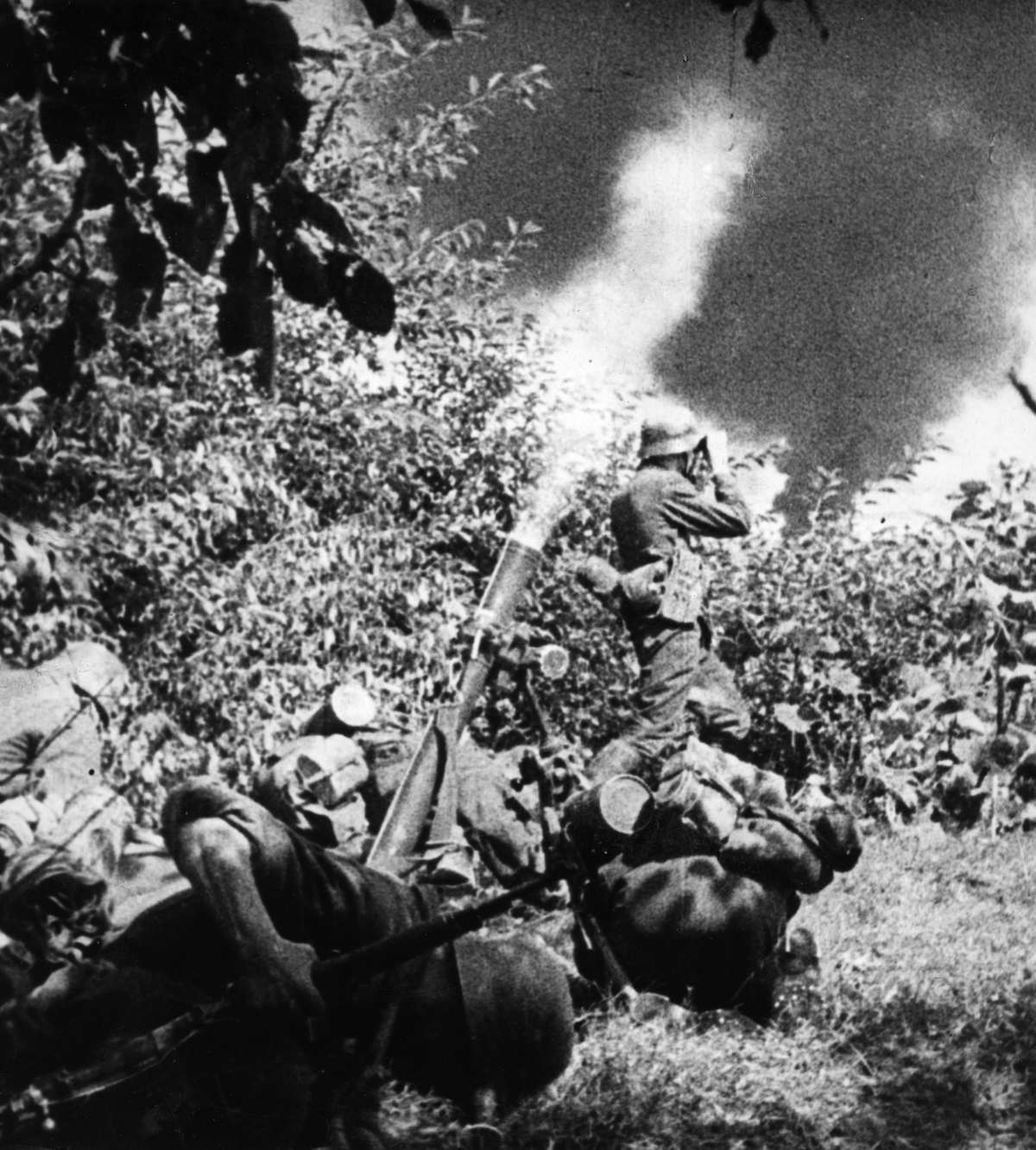
German Mortar firing
At the same time, the German 2nd Panzer Group, having repulsed the blow of the Soviet Bryansk Front near Trubchevsk, entered the operational space. On September 9, Model ‘s 3rd Panzer Division broke through to the south and captured Romney on September 10.
Meanwhile, on September 12, the 1st Panzer Group launched an offensive from the Kremenchug bridgehead in a northerly direction. On 15 September the 1st and 2nd Panzer Groups linked up at Lokhvitsa. The main forces of the Soviet Southwestern Front ended up in the giant Kiev “cauldron”; the number of prisoners was 665 thousand people. It turned out that the administration of the South-Western Front was defeated; the front commander, Colonel-General M.P. Kirponos was killed.
As a result, the Right-Bank Ukraine was in the hands of the enemy, the way to the Donbass was opened, the Soviet troops in the Crimea were cut off from the main forces. In mid-September, the Germans reached the approaches to the Crimea.
Continuation of the offensive in the south
The Crimea was of strategic importance as one of the routes to the oil-bearing regions of the Caucasus (through the Kerch Strait and Taman). In addition, the Crimea was important as a base for aviation. With the loss of the Crimea, Soviet aviation would have lost the possibility of raids on the oil fields of Romania, and the Germans would have been able to strike at targets in the Caucasus. The Soviet command understood the importance of holding the peninsula and concentrated on this, abandoning the defense of Odessa. On October 16 Odessa fell.
On October 8, in the direction of the Sea of \u200b \u200bAzov, the 18th Army of the Southern Front was surrounded and defeated.
On October 17, the Donbass was occupied (Taganrog fell), on October 25, Kharkov was captured, on November 2, the Crimea was occupied and Sevastopol was blocked. On November 30, the forces of the Army Group “South” entrenched themselves at the turn of the Mius Front.
Operation Barbarossa – The crisis of the plan to “Barbarossa”
Already at the end of July 1941, the German command was forced to introduce adjustments to the first phase of the blitzkrieg – the offensive operation “Barbarossa”.
Directive No. 33
In OKW Directive No. 33 of July 19, 1941, “FURTHER WARGING IN THE EAST”, the results of the “Second Offensive in the East” were summed up:
The second offensive in the East ended with a breakthrough of the Stalin line along the entire front and a further deep advance of tank groups in an easterly direction. Army Group Center will need considerable time to eliminate the strong enemy combat groups that continue to remain between our mobile formations
– “Military History Journal”, 1959, No. 6, p. 79-81
Addendum to Directive No. 33
After the report of the Commander-in-Chief of the Ground Forces, Hitler on July 22, 1941 supplemented Directive No. 33:
1) The southern section of the Eastern Front. The enemy, still located west of the Dnieper, must be finally defeated and completely eliminated. As soon as the operational and logistical situation allows, the 1st and 2nd tank groups should be united under the leadership of the commander of the 4th tank army and, together with the infantry and mountain rifle divisions following them, after mastering the Kharkov industrial region, launch an offensive across the Don to the Caucasus.
– “Military History Journal”, 1959, No. 6, p. 82-83
It is clarified that “the primary task of the bulk of the infantry divisions is the capture of Ukraine, the Crimea and the territory of the RSFSR to the Don.” But the Army Group “Center” at the same time “… must defeat the enemy, which continues to be in the area between Smolensk and Moscow, move its left flank as far as possible to the east and capture Moscow.” Moreover, “the 3rd Panzer Group is temporarily transferred to the command of the North Army Group with the task of ensuring the right flank of the latter and encircling the enemy in the Leningrad region.”
OKW Directive No. 34
It was published on July 30, 1941 as a reaction to “the development of events in recent days, the appearance of large enemy forces in front of the front and on the flanks of Army Group Center”. It is also stated: “The need to provide the 2nd and 3rd tank groups for the restoration and replenishment of their formations for about ten days forced me to temporarily postpone the implementation of the goals and tasks set in directive No. 33 of 19.7 and in addition to it of 23.7.”
Accordingly, “GA “Center” goes on the defensive, using the most convenient areas for this.”
The task on the southern sector of the front is “for the time being, to continue operations with the forces of only the Army Group” South “”.
Addendum to Directive No. 34
On August 12, 1941, Hitler orders “the attack on the city of Kiev to be suspended”, and the city itself “must be destroyed by incendiary bombs and artillery fire.”
It is also stated that “after the complete elimination of the threatening situation on the flanks and the replenishment of tank groups, conditions will be created for an offensive on a wide front by deeply echeloned flank groupings against large enemy forces concentrated for the defense of Moscow”, “in order to master the entire complex of state economic and communication centers of the enemy in the Moscow region.
Turning Away from Moscow
At the end of July 1941, the German command was still full of optimism and believed that the goals set by the Barbarossa plan would be achieved in the near future. As the deadlines for achieving these goals were indicated: Moscow and Leningrad – August 25; the border of the Volga – the beginning of October; Baku and Batumi – early November.
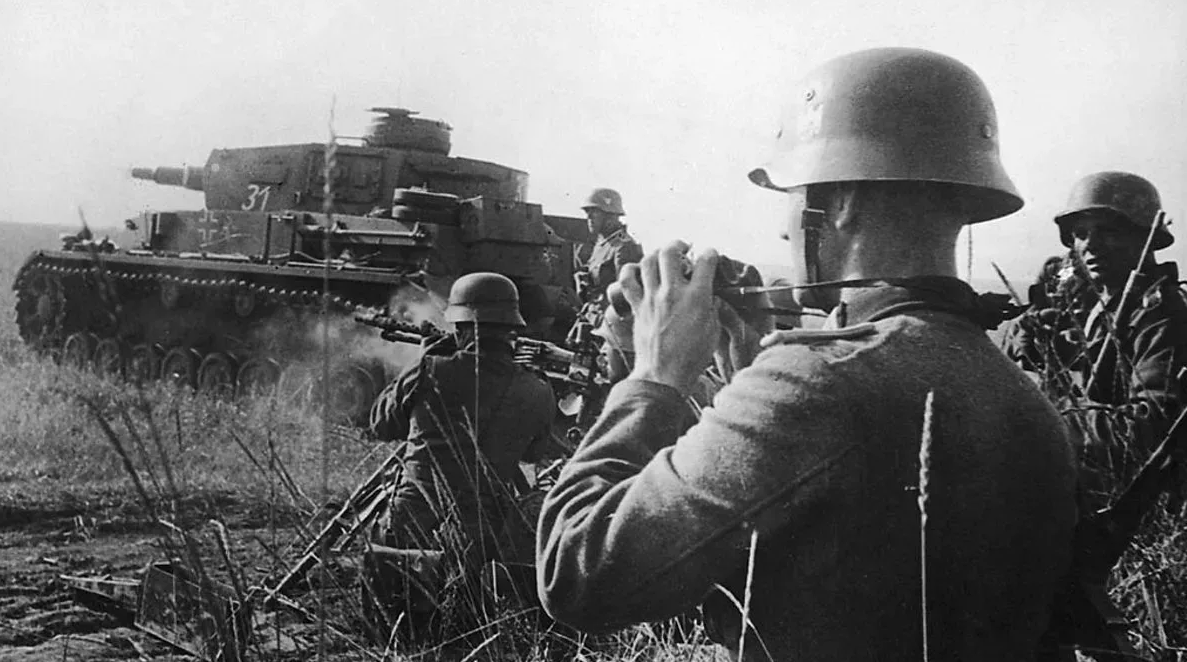
German Combined Arms Advancing
On July 25, at a meeting of the chiefs of staff of the Eastern Front of the Wehrmacht, it was said about the implementation of Operation Barbarossa in time:
- Army Group North: Operations developed almost in full accordance with plans.
- Army Group Center: Before the start of the Battle of Smolensk, operations developed in accordance with plans, then development slowed down.
- Army Group South: Operations progressed slower in time than anticipated.
By July 27, the first discussions of a possible change in the direction of the main attack of Army Group Center date back. Jodl turns to Hitler with a proposal to continue the offensive against Moscow after the end of the battles near Smolensk, to which he receives the answer: “It is necessary to capture the Donetsk industrial region as soon as possible and thereby deprive the Russians of the opportunity to receive weapons and cut them off from oil sources.” On July 28, Hitler again repeated his opinion that the industrial region of Kharkov is more important to him than Moscow. Hitler became more and more inclined to postpone the attack on Moscow. At a meeting at the headquarters of Army Group South on August 4, he stated:First, Leningrad must be captured, for this the troops of the Gotha group are used. In the second place, the capture of the eastern part of Ukraine is carried out… And only in the last turn will an offensive be undertaken with the aim of capturing Moscow.
The next day, F. Halder clarified Hitler’s opinion with A. Jodl : “What are our main goals: do we want to defeat the enemy or are we pursuing economic goals (capturing Ukraine and the Caucasus)?” Jodl replied that the Führer believed that both goals could be achieved simultaneously. To the question: Moscow or Ukraine or Moscow and Ukraine should be answered: both Moscow and Ukraine. We must do this, because otherwise we will not be able to defeat the enemy before the onset of autumn.
On August 21, Hitler issued a new directive stating: “The most important task before the onset of winter is not the capture of Moscow, but the capture of the Crimea, industrial and coal areas on the Donets River and blocking the Russian oil routes from the Caucasus. In the north, such a task is to encircle Leningrad and link up with the Finnish troops.”
Evaluation of Hitler’s decision
Hitler’s decision to abandon the immediate attack on Moscow and turn the 2nd Army and 2nd Panzer Group to help Army Group South caused mixed assessments among the German command.
The commander of the 3rd Panzer Group, G. Goth wrote in his memoirs: “There was one weighty argument of operational importance at that time against the continuation of the offensive against Moscow. If in the center the defeat of the enemy troops stationed in Belarus was unexpectedly quick and complete, then in other directions the successes were not so great. For example, it was not possible to push back to the south an enemy operating south of Pripyat and west of the Dnieper. An attempt to drop the Baltic grouping into the sea was also unsuccessful. Thus, both flanks of the Army Group Center, when advancing to Moscow, were in danger of being attacked, in the south this danger was already making itself felt…”
- Guderian, commander of the German 2nd Panzer Group, wrote: “The battles for Kiev undoubtedly meant a major tactical success. However, the question of whether this tactical success was also of major strategic importance remains in doubt. Now everything depended on whether the Germans would be able to achieve decisive results even before the onset of winter, perhaps even before the onset of the autumn thaw period ”.
Only on September 30 did the German troops, having pulled up their reserves, go on the offensive against Moscow. However, the late start of the offensive, the stubborn resistance of the Soviet troops, difficult weather conditions in late autumn led to a halt in the offensive against Moscow and the failure of Operation Barbarossa as a whole.
The Results of Operation Barbarossa
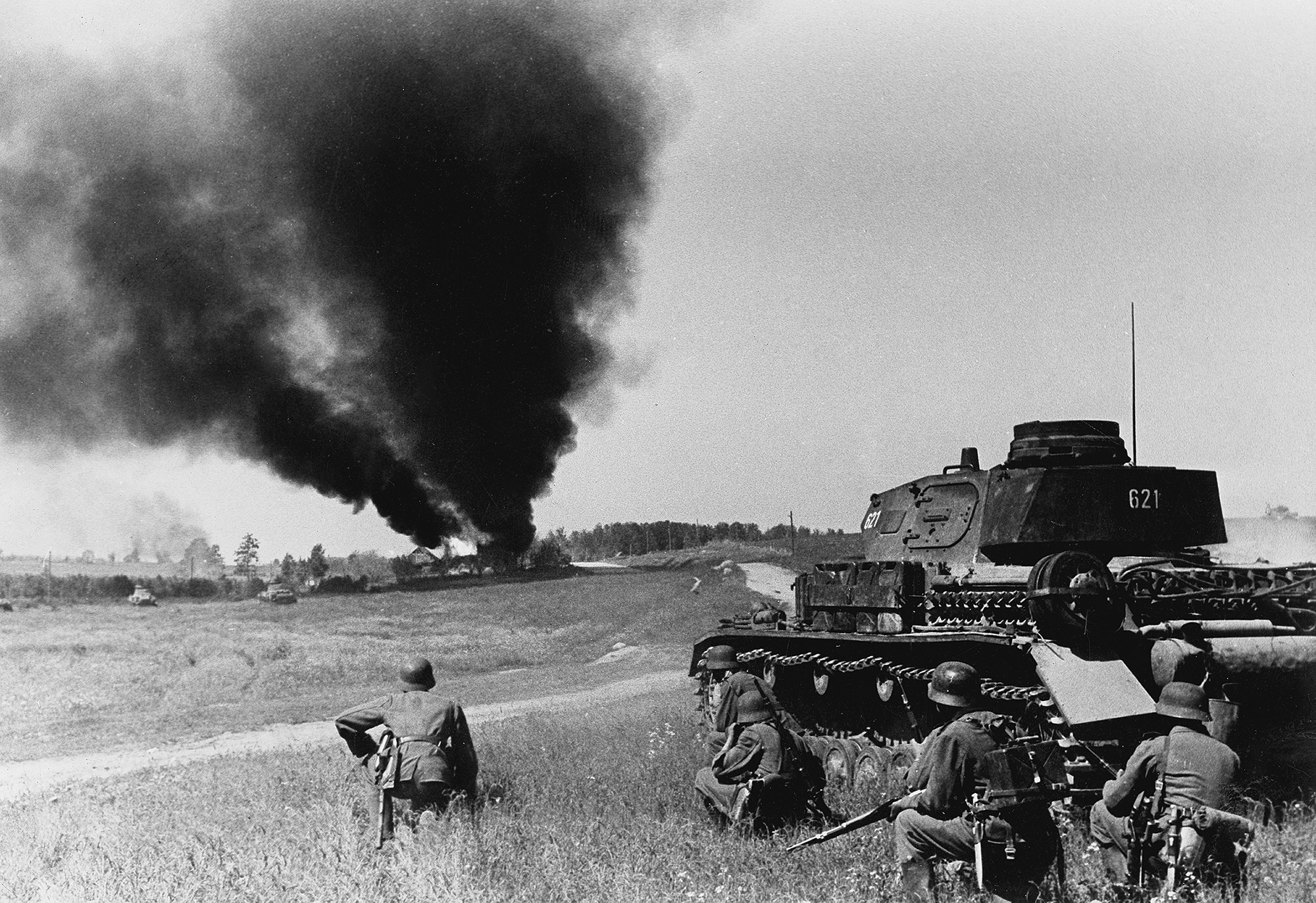
Battle for Soviet Village WW2
The ultimate goal of Operation Barbarossa remained unattained. Despite the impressive successes of the Wehrmacht, the attempt to defeat the USSR in one summer-autumn campaign failed.
This is based on a general underestimation of the Red Army and the mobilization capabilities of the USSR. Despite the fact that before the war the total number and composition of the Soviet troops were determined by the German command quite correctly, a major miscalculation should include an incorrect assessment of the USSR’s ability to form and arm new formations and formations of ground forces. By the third month of the war, no more than 40 new divisions of the Red Army were expected to be encountered. In fact, the Soviet leadership only sent 324 divisions to the front in the summer of 1941 (taking into account the previously deployed 222 divisions), that is, German intelligence was significantly mistaken in this matter. Already during the staff games held by the German General Staff, it became clear that the available forces would not be enough. The situation was especially difficult with reserves. Actually, The “Eastern Campaign” was to be won by one strategic echelon of troops. As a result of the staff games, it was found that with the successful development of operations on theater of operations, “which expands to the east like a funnel”, the German forces “will prove insufficient if it is not possible to inflict a decisive defeat on the Russians to the line Kiev – Minsk – Lake Peipsi “. Another conclusion was that the reserve of personnel of the Wehrmacht has only 400 thousand people, that is, it can cover the loss of personnel only until the fall. So, the operation should last no more than three months.
Meanwhile, on the line of the rivers Dnieper – Western Dvina, the Wehrmacht was waiting for the Second strategic echelon of Soviet troops, and behind him the Third strategic echelon was concentrated. An important stage in the disruption of the Barbarossa plan was the battle of Smolensk, in which the Soviet troops, despite heavy losses, stopped the advance of the enemy to the east.
The interaction between the army groups was complicated by the fact that they attacked in divergent directions – on Leningrad, Moscow and Kyiv. In this regard, the German command had to carry out private operations to protect the flanks of the central advancing group. These operations, although successful, led to a loss of time and wasted motor resources of the armored vehicles of the mechanized troops. Already in August, the question of the priority of goals arose: Leningrad, Moscow or Rostov-on-Don. When these goals came into conflict with each other, a crisis of command arose.
The goals set for the army groups were not achieved: “North” was unable to capture Leningrad, “South” – to make a deep envelopment of its left flank (6th and 17th armies) and destroy the main enemy troops on the right-bank Ukraine on schedule and, as a result, the troops of the Southwestern and Southern fronts were able to retreat to the Dnieper and gain a foothold. Later, the turn of the main forces of Army Group Center away from Moscow led to a loss of time and strategic initiative. In the autumn of 1941, the German command tried to find a way out of the crisis in the battle for Moscow – Operation Typhoon.
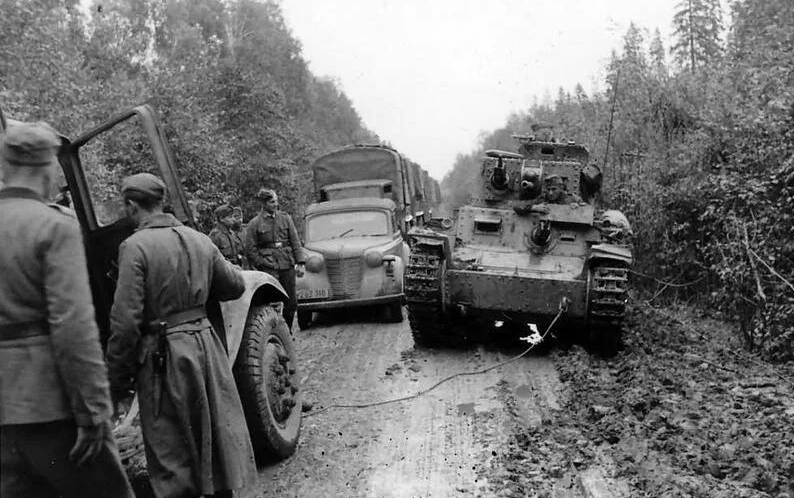
Towing Stuck Vehicle
The Australian historian David Steichel argues in his writings that the Wehrmacht was, in principle, incapable of winning wars comparable in scale to the one that unfolded on the German-Soviet front. Even if the German units moved deeper into enemy territory even faster, the outcome would be the same: the German army and the rear structures supporting it could not “digest” such an array of territories, people, and resources. According to Steikhel, in a strategic sense, the Wehrmacht lost the war by the end of the summer of 1941, by the beginning of the battle for Kyiv. Of course, the successes of the first months of the “eastern campaign” gave the Germans certain advantages, but in general they could not effectively control such vast territories. The small chance of winning given to the Germans in the second half of July, and connected with Japan’s hesitation about entering the war, was missed by them: the leadership of the Reich was unable to exert proper pressure on Tokyo. Everything else, according to the historian, was only a matter of time.
The 1941 campaign ended with the tactical defeat of the German forces in the central sector of the Soviet-German front near Moscow, on the northern flank near Tikhvin, and on the southern flank near Rostov.
Losses of German troops according to German data:
From June 22 to August 13, 1941, the entire eastern front lost 3,714 officers, 76,389 soldiers and non-commissioned officers killed. The number of wounded was 9,161 officers and 264,975 non-commissioned officers and soldiers. In total, this is just 10 percent of the number of troops on the eastern front!
– Haupt W. Battles of Army Group Center. — M.: Yauza, Eksmo, 2006
According to American military observers, German losses on December 11, 1941 amounted to 1.3 million killed.









